Paul van Yperen's Blog, page 372
August 27, 2015
Elina Bystritskaya
Actress Elina Bystritskaya (1928) was one of the most beautiful women of the Soviet cinema. Her most famous role is Aksinya in the epic film version of Mikhail Sholokhov's novel Tikhiy Don/And Quiet Flows the Don (1957-1958) by Sergei Gerasimov.
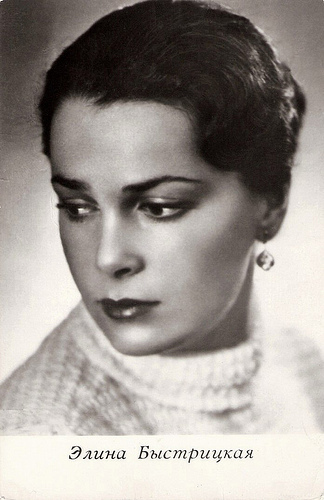
Russian postcard, 1966.
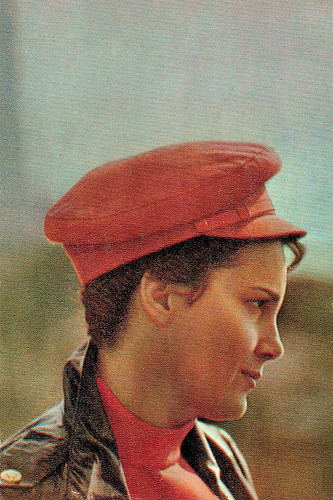
Russian postcard.
Socialist Realist Film
Elina Avraamovna Bystritskaya was born in 1928 in Kiev, Soviet Union (now: Ukrain). Her father, Avraam Petrovich Bystritsky, was a notable medical doctor in Kiev, her mother, Esther Isaakovna, was a medical administrator.
Young Elina worked as a medical nurse helping her parents in a Soviet military hospital during World War II. She was decorated by the Soviet State for her contribution.
From 1948-1953 she attended the Kiev Theatrical Institute, graduating in 1953 as an actress.
She co-starred with the later director Sergei Bondarchuk in Neokonchennaya povest/Unfinished Story (Fridrikh Ermler, 1955) an archetypal Socialist Realist film. With her role as a doctor in this film she shot to fame in the Soviet Union.
She was acclaimed as the Best Soviet actress of the year, and was a member of the Soviet delegation in Paris for the Week of Soviet Film there.
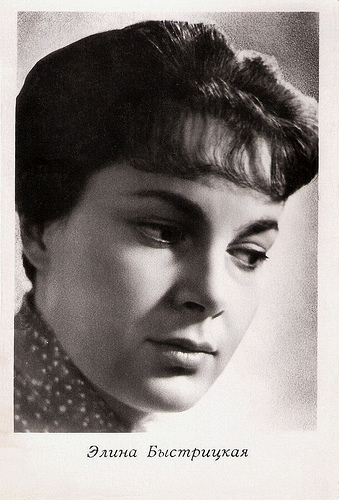
Russian postcard by Izdanije Byuro Propogandy Sovietskogo Kinoiskusstva, no. 3975, 1962. Retail price: 8 kop.
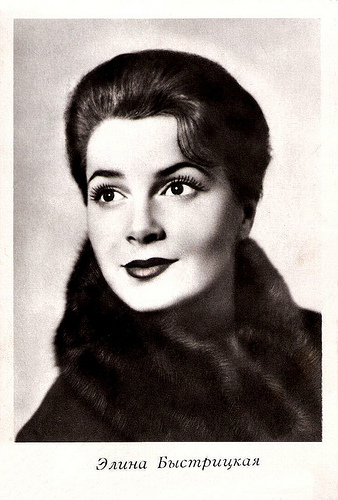
Russian postcard by Izdanije Byuro Propogandy Sovietskogo Kinoiskusstva, no. 4490, 1964. Retail price: 8 kop.
The Russian equivalent of Gone with the Wind
A year later, in 1956, Elina Bystritskaya was handpicked by writer Mikhail Sholokhov to co-star as Aksinya opposite Pyotr Glebov in the trilogy Tikhiy Don/And Quiet Flows the Don (Sergei Gerasimov, 1957-1958).
The three-part, 330 minutes lasting, epic film was released in 1957 (parts 1 and 2) and 1958 (part 3). It was based on Sholokhov's classic novel on life at the Don river valley directly before and after the coming of communism.
Proud and red-blooded Don Cossack Grigori (Glebov) comes home from the First World War and has a crush on dark-haired Aksinya, but she is already married - an unhappy marriage. Angered by the adulterous affair, Grigori's parents arrange a marriage with a village bride, but even after being married, Grigori cannot stop seeing Aksinya.
The tragedy is set against a background of great historic upheaval, including big battle scenes: the First World War, the Revolution and the Civil War, making it the Russian equivalent of Gone with the Wind.
In 1958, Bystritskaya turned to theatre work in the Maly Theatre in Moscow, and her screen appearances grew sporadic. Her later films include Vsyo ostayotsya lyudyam/Everything Remains for the People (Georgi Natanson, 1963), and Bravye parni (Nikolai Zaseyev, 1993).
In 1978 she was named People's Artist of the Year. She also taught acting at the Shchepkin school (Shchepkin Theatre School), and at the Soviet State Theatrical Institute (GITIS). Elina Bystritskaya lives in Moscow, Russia.
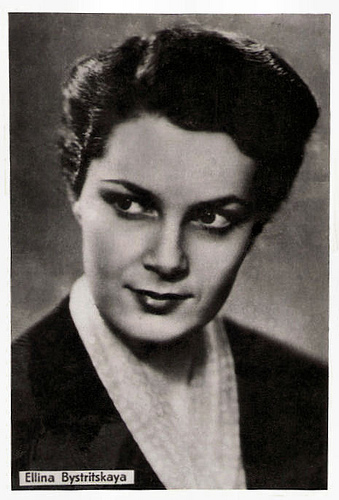
Small Romanian collectors card.
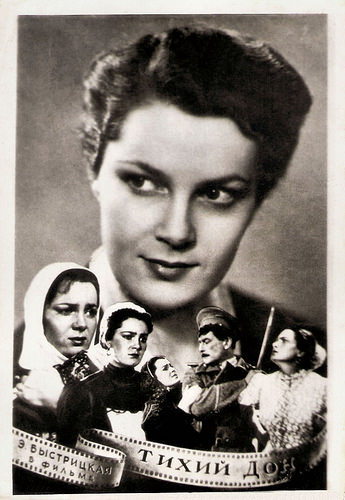
Russian card. Photo: combination of publicity stills for Tikhiy Don/And Quiet Flows the Don (Aleksandr Gerasimov, 1957).
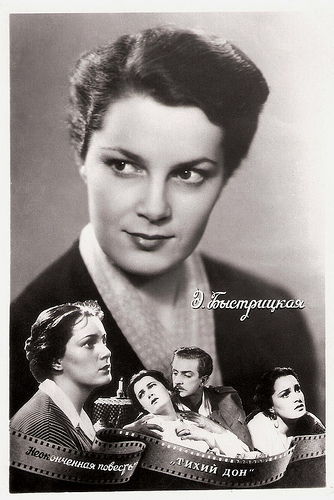
Russian postcard, no. A 506112. Price: 75 Kop. Released in an edition of 40,000 postcards.
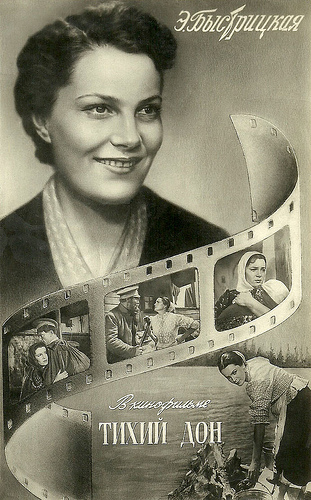
Russian postcard. Photo: compilation with still from Tikhiy Don/And Quiet Flows the Don (1957).
Love scenes from Tikhiy Don/And Quiet Flows the Don (1957-1958).Source: Elfiya (YouTube).
Sources: (IMDb), Russian Film Blogspot, Wikipedia, and .

Russian postcard, 1966.

Russian postcard.
Socialist Realist Film
Elina Avraamovna Bystritskaya was born in 1928 in Kiev, Soviet Union (now: Ukrain). Her father, Avraam Petrovich Bystritsky, was a notable medical doctor in Kiev, her mother, Esther Isaakovna, was a medical administrator.
Young Elina worked as a medical nurse helping her parents in a Soviet military hospital during World War II. She was decorated by the Soviet State for her contribution.
From 1948-1953 she attended the Kiev Theatrical Institute, graduating in 1953 as an actress.
She co-starred with the later director Sergei Bondarchuk in Neokonchennaya povest/Unfinished Story (Fridrikh Ermler, 1955) an archetypal Socialist Realist film. With her role as a doctor in this film she shot to fame in the Soviet Union.
She was acclaimed as the Best Soviet actress of the year, and was a member of the Soviet delegation in Paris for the Week of Soviet Film there.

Russian postcard by Izdanije Byuro Propogandy Sovietskogo Kinoiskusstva, no. 3975, 1962. Retail price: 8 kop.

Russian postcard by Izdanije Byuro Propogandy Sovietskogo Kinoiskusstva, no. 4490, 1964. Retail price: 8 kop.
The Russian equivalent of Gone with the Wind
A year later, in 1956, Elina Bystritskaya was handpicked by writer Mikhail Sholokhov to co-star as Aksinya opposite Pyotr Glebov in the trilogy Tikhiy Don/And Quiet Flows the Don (Sergei Gerasimov, 1957-1958).
The three-part, 330 minutes lasting, epic film was released in 1957 (parts 1 and 2) and 1958 (part 3). It was based on Sholokhov's classic novel on life at the Don river valley directly before and after the coming of communism.
Proud and red-blooded Don Cossack Grigori (Glebov) comes home from the First World War and has a crush on dark-haired Aksinya, but she is already married - an unhappy marriage. Angered by the adulterous affair, Grigori's parents arrange a marriage with a village bride, but even after being married, Grigori cannot stop seeing Aksinya.
The tragedy is set against a background of great historic upheaval, including big battle scenes: the First World War, the Revolution and the Civil War, making it the Russian equivalent of Gone with the Wind.
In 1958, Bystritskaya turned to theatre work in the Maly Theatre in Moscow, and her screen appearances grew sporadic. Her later films include Vsyo ostayotsya lyudyam/Everything Remains for the People (Georgi Natanson, 1963), and Bravye parni (Nikolai Zaseyev, 1993).
In 1978 she was named People's Artist of the Year. She also taught acting at the Shchepkin school (Shchepkin Theatre School), and at the Soviet State Theatrical Institute (GITIS). Elina Bystritskaya lives in Moscow, Russia.

Small Romanian collectors card.

Russian card. Photo: combination of publicity stills for Tikhiy Don/And Quiet Flows the Don (Aleksandr Gerasimov, 1957).

Russian postcard, no. A 506112. Price: 75 Kop. Released in an edition of 40,000 postcards.

Russian postcard. Photo: compilation with still from Tikhiy Don/And Quiet Flows the Don (1957).
Love scenes from Tikhiy Don/And Quiet Flows the Don (1957-1958).Source: Elfiya (YouTube).
Sources: (IMDb), Russian Film Blogspot, Wikipedia, and .
Published on August 27, 2015 22:00
August 26, 2015
Ressel Orla
Dark-haired and wide-eyed Ressel Orla (1889-1931) was a popular actress of the German silent cinema who peaked in the late 1910s and early 1920s. The now mostly forgotten star appeared in some of the early films by Ernst Lubitsch and Fritz Lang.
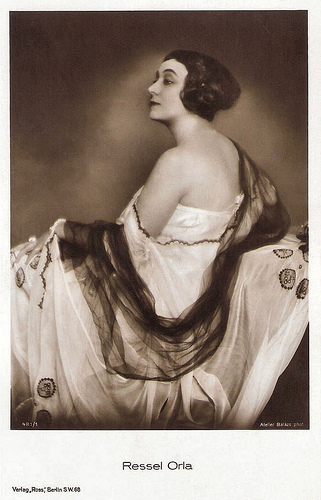
German postcard by Ross Verlag, Berlin, no. 481/1, 1919-1924. Photo: Atelier Balázs.
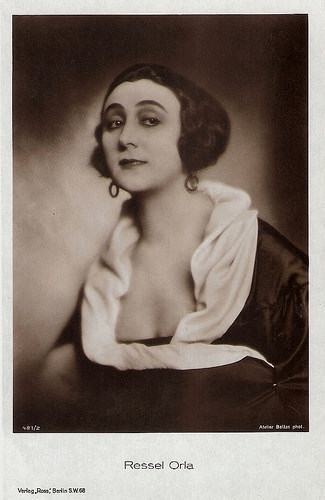
German postcard by Ross Verlag, Berlin, no. 481/2, 1919-1924. Photo: Atelier Balázs.

German postcard by Ross Verlag, Berlin, no. 481/3, 1919-1924. Photo: Atelier Balázs.
Madonna-like Face
Ressel Orla was born Therese Ochs in Bozen (Bolzano) in Austria-Hungary (now Italy) in 1889.
In 1907 she began her stage career at the Metropoltheater in Hannover, Germany, and continued to play there in other theatres. In 1910 she moved to Düsseldorf, in 1912 to Bad Nenndorf, and finally to Berlin, where she played at the Residenztheater.
Here Walter Turszinsky discovered her and engaged her for the film comedy Die Firma heiratet/The Perfect Thirty-Six (Carl Wilhelm, 1914), for which Turszinsky had written the script. Her co-star was Ernst Lubitsch .
With no offers coming in for stage work, she continued film work with much success. Orla played in two other film comedies with Lubitsch either as actor or director, Die Stolz der Firma/The Pride of the Firm (Carl Wilhelm, 1914) and Blindekuh/Blind Cow (Ernst Lubitsch, 1915).
With her dark hair, her wide eyes and her Madonna-like face, Orla conquered German audiences and became a star in the late 1910s. In 1918 she impersonated her first dramatic film role in Die Sünde/The Sin (Alwin Neuss, 1918). It was the first film of her own Ressel Orla film series for the Decla company of producer Erich Pommer.
Another of these films was Fritz Lang's first film direction Halbblut/The Half-Caste (1919). Earlier, Lang had been the scriptwritter for Orla's film Die Frauen des Josias Grafenreuth/The Women of Josef Grafenreuth (Otto Rippert, 1918). Her most important role was that of the dangerous and deadly Lio Sha, leader of a secret society of criminals in Lang's two-part adventure Die Spinnen/Spiders (Fritz Lang, 1919-1920) starring Carl de Vogt as a brave explorer.
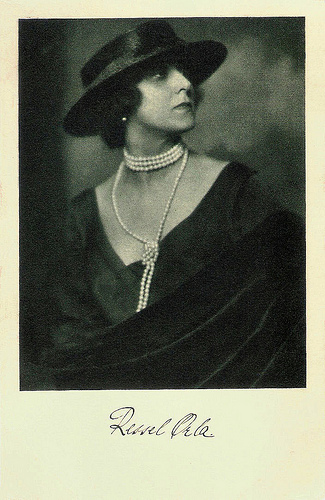
German postcard by Verlag W.J. Morlins / Ross Verlag, Berlin, no. 9010/2. Photo: Karl Schenker.
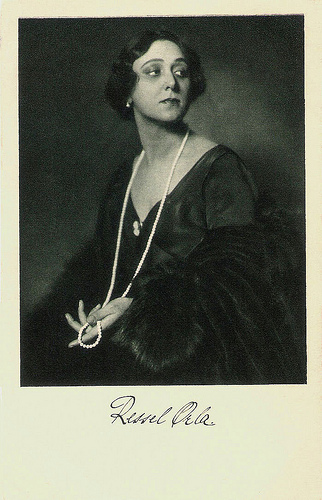
German postcard by Verlag W.J. Morlins / Ross Verlag, Berlin, no. 9010/3. Photo: Karl Schenker.
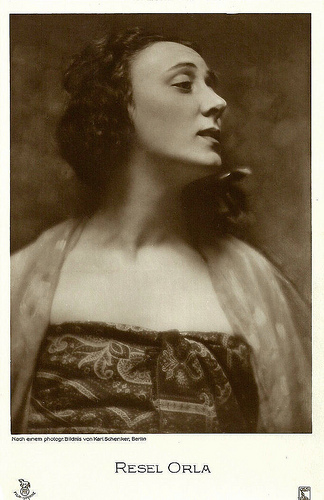
German postcard by Rotophot in the Film-Sterne series. Photo: Karl Schenker, Berlin.
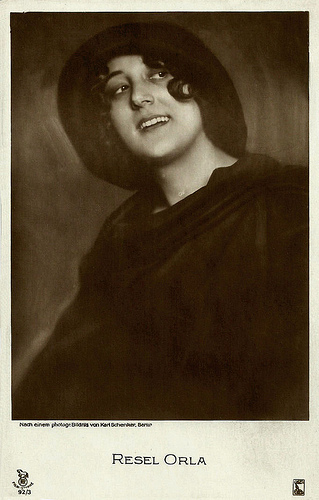
German postcard by Rotophot in the Film-Sterne series, no. 92/3, 1919-1924. Photo: Karl Schenker, Berlin.
Terrible Illness
In the early 1920s, Ressel Orla made several films with director Carl Wilhelm, including Die Sippschaft/The Tribe (1920), Die Augen der Welt/The Eyes of the World (Carl Wilhelm, 1920) with Conrad Veidt , and Anständige Fraue/Decent Women (Carl Wilhelm, 1921).
After that the expressive and beautiful Orla appeared in a whole series of films with director Leo Lasko such as Satansketten/Satan's chains (Leo Lasko, 1921), Pariserinnen/Parisians (Leo Lasko, 1921) with Xenia Desni , Lebenshunger/Lust for Life (Leo Lasko, 1921), and Die Lou vom Montmartre/Lou of Montmartre (Leo Lasko, 1921).
Other films in which she was the female protagonist were a.o. Monte Carlo (Fred Sauer, 1921), Die Wölfin/The She-Wolf (Rolf Brunner, 1921), Frau Schlange/Mrs. Snake (Eugen Holstein, 1923), and Frauen die den Weg verloren/Women Who Lost the Way (Bruno Rahn, 1926) with Oscar Marion .
Apart from these starring roles, Orla more and more had to share the female parts, with such actresses as Carola Toelle , Lya Mara , Henny Porten , Aud Egede Nissen , Claire Rommer , and Grit Haid . All through the 1920s Ressel Orla performed in many films, though less frequent in the second half of the decade.
Her last film role was a small part in Lockendes Gift/Tempting Poison (Fred Sauer, 1929) with Paul Richter . In 1929 a terrible illness prevented her to continue performing and eventually the illness killed her, in 1931 in Berlin. At the time of her death, she had fallen on hard times, was no longer acting, and was barely forty.
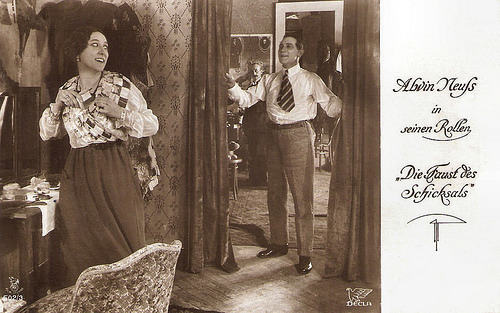
German postcard by Rotophot in the Film Sterne series, no. 502/3. Photo: Decla. Publicity still for Die Faust des Schicksals/Fist of Doom (Alwin Neuss, 1917) with Ressel Orla and Alwin Neuss .
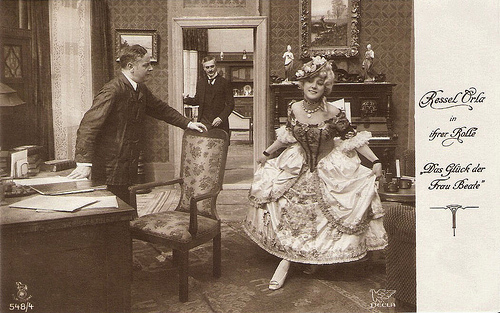
German postcard by Rotophot in the Film Sterne series, no. 548/4, 1919-1924. Photo: Decla. Publicity still for Das Glück der Frau Beate/The luck of the Mrs. Beate (Alwin Neuss, Otto Rippert, 1918).
Sources: Thomas Staedeli (Cyranos), Filmhistoriker.de, Filmportal.de, Wikipedia (German), and .

German postcard by Ross Verlag, Berlin, no. 481/1, 1919-1924. Photo: Atelier Balázs.

German postcard by Ross Verlag, Berlin, no. 481/2, 1919-1924. Photo: Atelier Balázs.

German postcard by Ross Verlag, Berlin, no. 481/3, 1919-1924. Photo: Atelier Balázs.
Madonna-like Face
Ressel Orla was born Therese Ochs in Bozen (Bolzano) in Austria-Hungary (now Italy) in 1889.
In 1907 she began her stage career at the Metropoltheater in Hannover, Germany, and continued to play there in other theatres. In 1910 she moved to Düsseldorf, in 1912 to Bad Nenndorf, and finally to Berlin, where she played at the Residenztheater.
Here Walter Turszinsky discovered her and engaged her for the film comedy Die Firma heiratet/The Perfect Thirty-Six (Carl Wilhelm, 1914), for which Turszinsky had written the script. Her co-star was Ernst Lubitsch .
With no offers coming in for stage work, she continued film work with much success. Orla played in two other film comedies with Lubitsch either as actor or director, Die Stolz der Firma/The Pride of the Firm (Carl Wilhelm, 1914) and Blindekuh/Blind Cow (Ernst Lubitsch, 1915).
With her dark hair, her wide eyes and her Madonna-like face, Orla conquered German audiences and became a star in the late 1910s. In 1918 she impersonated her first dramatic film role in Die Sünde/The Sin (Alwin Neuss, 1918). It was the first film of her own Ressel Orla film series for the Decla company of producer Erich Pommer.
Another of these films was Fritz Lang's first film direction Halbblut/The Half-Caste (1919). Earlier, Lang had been the scriptwritter for Orla's film Die Frauen des Josias Grafenreuth/The Women of Josef Grafenreuth (Otto Rippert, 1918). Her most important role was that of the dangerous and deadly Lio Sha, leader of a secret society of criminals in Lang's two-part adventure Die Spinnen/Spiders (Fritz Lang, 1919-1920) starring Carl de Vogt as a brave explorer.

German postcard by Verlag W.J. Morlins / Ross Verlag, Berlin, no. 9010/2. Photo: Karl Schenker.

German postcard by Verlag W.J. Morlins / Ross Verlag, Berlin, no. 9010/3. Photo: Karl Schenker.

German postcard by Rotophot in the Film-Sterne series. Photo: Karl Schenker, Berlin.

German postcard by Rotophot in the Film-Sterne series, no. 92/3, 1919-1924. Photo: Karl Schenker, Berlin.
Terrible Illness
In the early 1920s, Ressel Orla made several films with director Carl Wilhelm, including Die Sippschaft/The Tribe (1920), Die Augen der Welt/The Eyes of the World (Carl Wilhelm, 1920) with Conrad Veidt , and Anständige Fraue/Decent Women (Carl Wilhelm, 1921).
After that the expressive and beautiful Orla appeared in a whole series of films with director Leo Lasko such as Satansketten/Satan's chains (Leo Lasko, 1921), Pariserinnen/Parisians (Leo Lasko, 1921) with Xenia Desni , Lebenshunger/Lust for Life (Leo Lasko, 1921), and Die Lou vom Montmartre/Lou of Montmartre (Leo Lasko, 1921).
Other films in which she was the female protagonist were a.o. Monte Carlo (Fred Sauer, 1921), Die Wölfin/The She-Wolf (Rolf Brunner, 1921), Frau Schlange/Mrs. Snake (Eugen Holstein, 1923), and Frauen die den Weg verloren/Women Who Lost the Way (Bruno Rahn, 1926) with Oscar Marion .
Apart from these starring roles, Orla more and more had to share the female parts, with such actresses as Carola Toelle , Lya Mara , Henny Porten , Aud Egede Nissen , Claire Rommer , and Grit Haid . All through the 1920s Ressel Orla performed in many films, though less frequent in the second half of the decade.
Her last film role was a small part in Lockendes Gift/Tempting Poison (Fred Sauer, 1929) with Paul Richter . In 1929 a terrible illness prevented her to continue performing and eventually the illness killed her, in 1931 in Berlin. At the time of her death, she had fallen on hard times, was no longer acting, and was barely forty.

German postcard by Rotophot in the Film Sterne series, no. 502/3. Photo: Decla. Publicity still for Die Faust des Schicksals/Fist of Doom (Alwin Neuss, 1917) with Ressel Orla and Alwin Neuss .

German postcard by Rotophot in the Film Sterne series, no. 548/4, 1919-1924. Photo: Decla. Publicity still for Das Glück der Frau Beate/The luck of the Mrs. Beate (Alwin Neuss, Otto Rippert, 1918).
Sources: Thomas Staedeli (Cyranos), Filmhistoriker.de, Filmportal.de, Wikipedia (German), and .
Published on August 26, 2015 22:00
August 25, 2015
Imported from the USA: Jayne Mansfield
Some Hollywood stars were much more popular in Europe than at home. A fabulous example is sweet Jayne Mansfield (1933-1967), one of Hollywood's original platinum blonde bombshells. Although most of her American films did not do much at the European box offices, Jayne herself was a sensation whenever she came to Europe to promote her films. During the 1960s when Hollywood had lost its interest in her, Jayne continued to appear cheerfully in several European films.
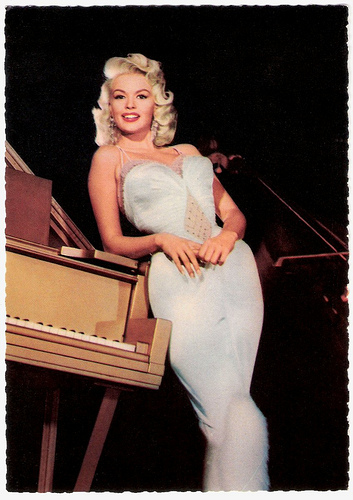
German postcard by ISV, no. A 60. Photo: 20th Century Fox. Publicity still for The Girl Can't Help It (Frank Tashlin, 1956).
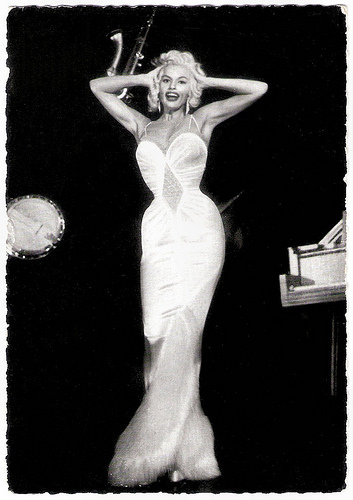
German postcard by Filmbilder-Vertrieb Ernst Freihoff, Essen. Retail price: 10 Pfg. Photo: Centfox. Publicity still for The Girl Can't Help It (Frank Tashlin, 1956).
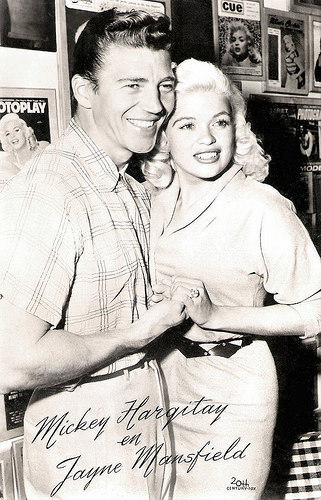
With Mickey Hargitey. Dutch postcard by Uitgeverij Takken, no. 3674. Photo: 20th Century Fox.
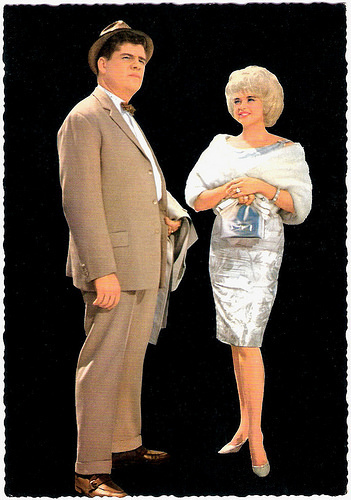
With Bill Ramsey . German postcard by Krüger, no. 902/219. Photo: Bernard of Hollywood (credited on the postcard). Possibly made for Heimweh nach St. Pauli (Werner Jacobs, 1963) in which Mansfield and Ramsey played supporting parts. However, IMDb credits Lothar Winkler as the stills photographer of this Schlager film in which Mansfield sings the classic Snicksnack Snucklechen.

German postcard by Krüger, no. 900/78. Photo: Bernard of Hollywood.
Shocking The Nation
In 1957 Jayne Mansfield did a legendary promotional visit to the Netherlands. The film she promoted, Kiss Them for Me (Stanley Donen, 1957), was quickly forgotten, but forty years later her visit was dearly remembered with an exhibition, a book and a TV documentary.
Obviously, Jayne shocked the nation while showing her voluptuous figure in a tight sweater and doing her interviews with her lisp, breathless voice. During her visit, photographers went wild. With the photo and film coverage you can easily reconstruct now her complete trip. And with all the cameras around her, Jayne kept on smiling and posing.
We can see her glorious entrance at the stairs of the KLM airplane, Jayne drinking champagne from a wooden clog, posing on a table at the offices of the Dutch newspaper De Telegraaf, surrounded by dozens of marines on a war ship, at the premiere of her film in cinemas in Amsterdam and The Hague, interviewed on TV by Dutch celebrity Wim Sonneveld , kissing DOS goal keeper and one time film star Frans de Munck before a soccer match, posing sweetly in a Volendam costume, and finally Jayne waving from the airplane that flew her to another country, her next stop of the promo tour.
Jayne was a phenomenon - all over Europe.
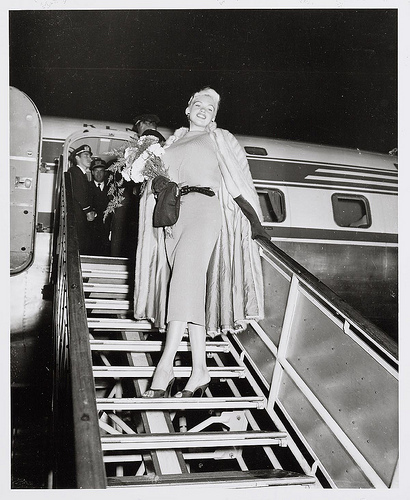
Jayne Mansfield, Arriving at Schiphol, 10 October 1957. Photo: Ben van Meerendonk / AHF. Collection: IISG, Amsterdam (Flickr).
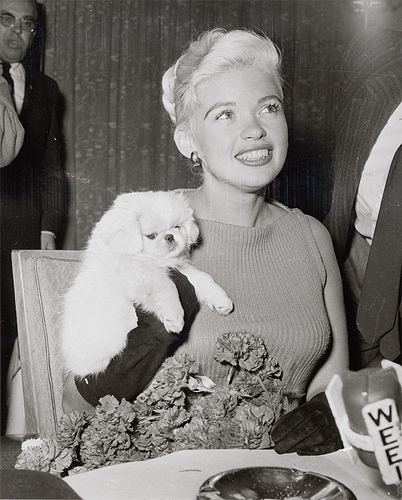
Jayne with her dog Powderpuff, Press Conference at Schiphol, 10 October 1957. Photo: Ben van Meerendonk / AHF. Collection: IISG, Amsterdam (Flickr).
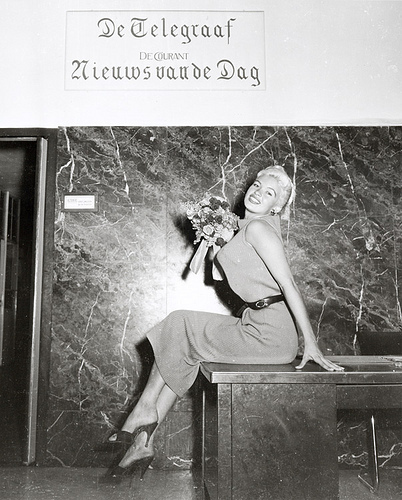
Jayne Mansfield visits the offices of De Telegraaf, 10 October 1957. Photo: Ben van Meerendonk / AHF. Collection: IISG, Amsterdam (Flickr).
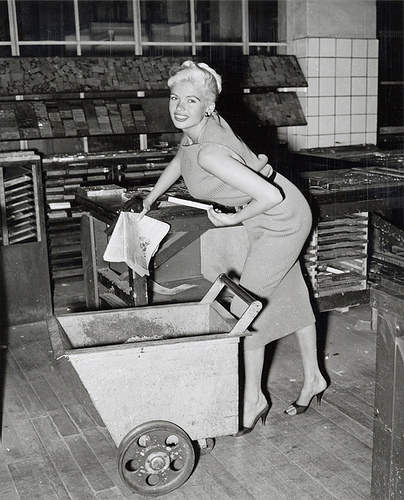
Jayne Mansfield visits the printers of De Telegraaf, 10 October 1957. Photo: Ben van Meerendonk / AHF. Collection: IISG, Amsterdam (Flickr).
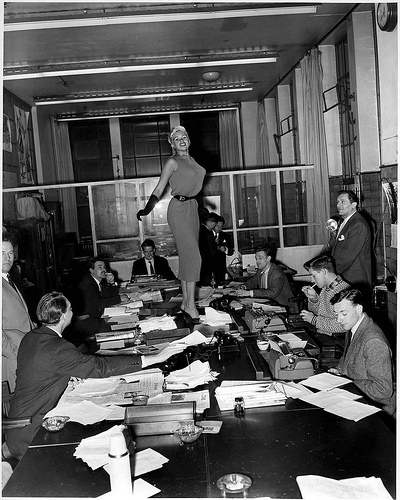
Jayne Mansfield on the editors table during her visit at the De Telegraaf, 10 October 1957. Photo: Ben van Meerendonk / AHF. Collection: IISG, Amsterdam (Flickr).
Prominent, Problematic Breasts
Jayne Mansfield was born Vera Jayne Palmer in Bryn Mawr, Pennsylvania in 1933. She was the only child of Herbert William, a successful attorney of German ancestry, and Vera Jeffrey Palmer of English descent. While attending the University of Texas at Austin, Mansfield won several beauty contests. However her prominent breasts were considered problematic, and led to her losing her first professional assignment—an advertising campaign for General Electric.
A natural brunette, Mansfield had her hair bleached and coloured platinum blonde when she moved to Los Angeles. She posed nude for the February 1955 issue of Playboy, modelling in pyjamas raised so that the bottoms of her breasts showed. This helped launch Mansfield's career, and that year, she became a major Broadway star as Marilyn Monroe-like actress Rita Marlowe in the Broadway version of George Axelrod's play Will Success Spoil Rock Hunter?
This role won her a contract at 20th Century Fox. The following year, she reprised the role in the film version, Will Success Spoil Rock Hunter? (Frank Tashlin, 1957), with Tony Randall, and became a major Hollywood star. She showcased her comedic skills in The Girl Can't Help It (Frank Tashlin, 1956), and her dramatic assets in The Wayward Bus (Victor Vicas, 1957) opposite Joan Collins .
Hal Erickson at AllMovie : “Despite good dramatic performances in such films as The Wayward Bus (1957), Kiss Them for Me (1957), and The Burglar (1957), Mansfield was forever typed as a parody Marilyn Monroe.” By the late 1950s, with the decrease of the demand for big-breasted blonde bombshells and the increase in the negative backlash against her over-publicity, she became a box-office has-been.
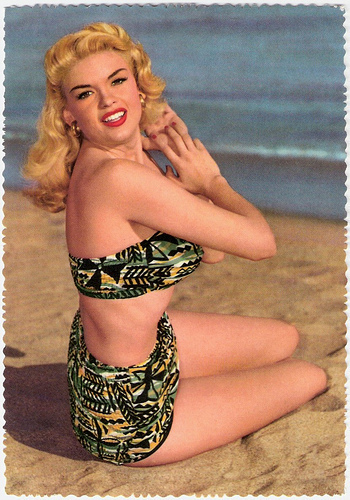
Italian postcard by Rotalcolor, no. 3.
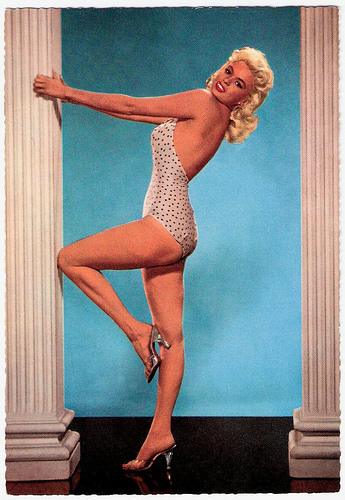
German postcard by ISV, Sort IV/6.
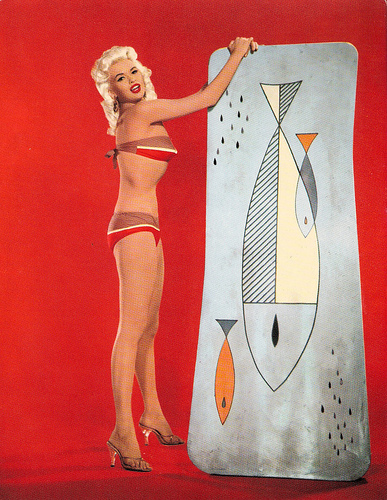
Big German postcard by ISV, no. PX 5.
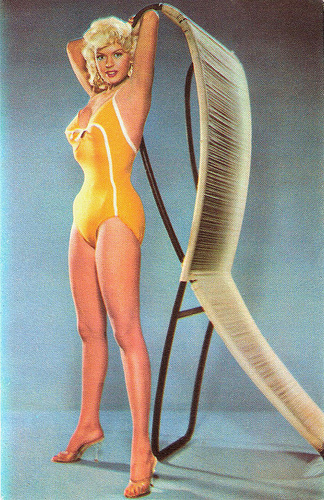
French postcard by Huit, Paris / ISV, no. D 25. Photo: Film-Press.
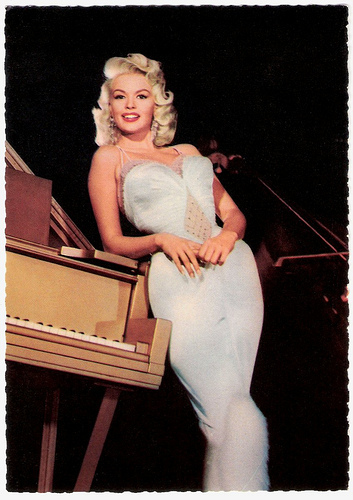
German postcard by ISV, no. A 60. Photo: 20th Century Fox. Publicity still for The Girl Can't Help It.
Bernard of Hollywood
While Hollywood studios lost interest in her, Jayne Mansfield’s film career continued in Europe with films in United Kingdom, Italy, Germany, and Greece. 20th Century Fox loaned her out for the British neo-noir thriller Too Hot to Handle/Playgirl After Dark (Terence Young, 1960). Jayne played a nightclub dancer opposite Leo Genn, Karlheinz Böhm and Christopher Lee . In Britain, she also appeared The Challenge/It Takes a Thief (John Gilling, 1960) with Anthony Quayle and Carl Möhner .
Hollywood then sent her to Italy for Gli amori di Ercole/The Loves of Hercules (Carlo Ludovico Bragaglia, 1960) opposite muscleman and husband Mickey Hargitey. Bruce Eder at AllMovie : “a fairly lavishly produced but otherwise relatively undistinguished sword-and-sandal adventure.”
After her contract with 20th Century Fox ended, she made in Germany Heimweh nach St. Pauli/Homesick for St. Pauli (Werner Jacobs, 1963) starring Schlager star Freddy Quinn , and Einer frisst den anderen/Dog Eat Dog (Gustav Gavrin, 1964).
Mark Deming at AllMovie describes the latter as an “offbeat but stylish crime drama”. At the time, she was photographed in Germany by legendary glamour photographer Bernard of Hollywood (a.k.a. Bruno Bernard) , which resulted in a series of very sexy and popular postcards. Jayne moved on to Italy for the comedies L'Amore Primitivo/Primitive Love (Luigi Scattini, 1964), and Panic Button (George Sherman, Giuliano Carnimeo, 1964) with Maurice Chevalier .
During the 1960s, Mansfield remained a highly visible celebrity, through her publicity antics and her daring performances in international nightclubs. In early 1967, she filmed her last screen role: a cameo in A Guide for the Married Man (Gene Kelly, 1967), a comedy starring Walter Matthau.
Mansfield had taken her professional name from her first husband, public relations professional Paul Mansfield, with whom she married in 1950 at age 16, and with whom she had a daughter. She was the mother of three children from her second marriage to actor–bodybuilder Mickey Hargitay (1958-1964). She married her third husband, Italian-born film director Matt Cimber/Matteo Ottaviano in 1964, and separated from him in 1966. Mansfield and Cimber had a son.
In 1967, while driving to a club engagement in New Orleans, Jayne Mansfield died in a car accident. She was only 34 years old at the time. Her fourth child, Mariska Hargitay, would later become a well-known TV actress.
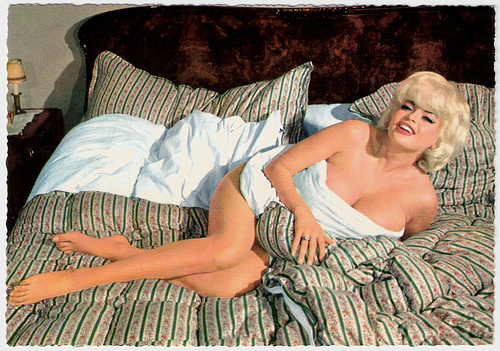
German postcard by Krüger, no. 900/78. Photo: Bernard of Hollywood.
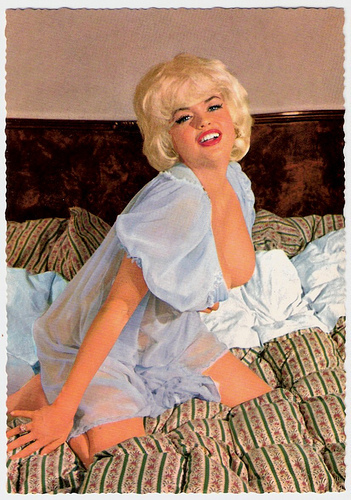
German postcard by Krüger, no. 900/78. Photo: Bernard of Hollywood.
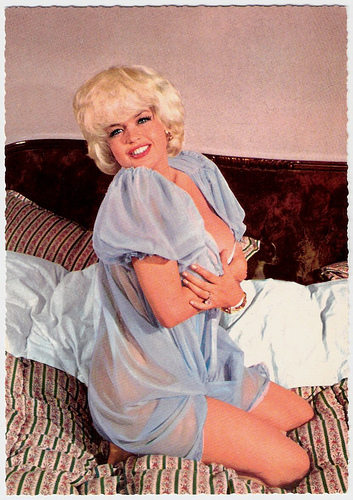
German postcard by Krüger, no. 900/78. Photo: Bernard of Hollywood.
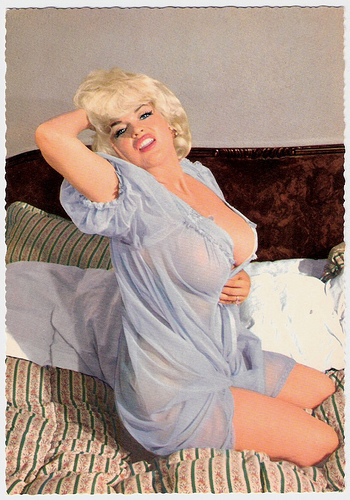
German postcard by Krüger, no. 900/78. Photo: Bernard of Hollywood.

German postcard by Krüger, no. 900/78. Photo: Bernard of Hollywood.
Sources: Hal Erickson (AllMovie), Herman Selier (De terugkeer van Jayne Mansfield in Nederland) (Dutch), (IMDb), Mark Deming (AllMovie), Bruce Eder (AllMovie), Wikipedia, and .

German postcard by ISV, no. A 60. Photo: 20th Century Fox. Publicity still for The Girl Can't Help It (Frank Tashlin, 1956).

German postcard by Filmbilder-Vertrieb Ernst Freihoff, Essen. Retail price: 10 Pfg. Photo: Centfox. Publicity still for The Girl Can't Help It (Frank Tashlin, 1956).

With Mickey Hargitey. Dutch postcard by Uitgeverij Takken, no. 3674. Photo: 20th Century Fox.

With Bill Ramsey . German postcard by Krüger, no. 902/219. Photo: Bernard of Hollywood (credited on the postcard). Possibly made for Heimweh nach St. Pauli (Werner Jacobs, 1963) in which Mansfield and Ramsey played supporting parts. However, IMDb credits Lothar Winkler as the stills photographer of this Schlager film in which Mansfield sings the classic Snicksnack Snucklechen.

German postcard by Krüger, no. 900/78. Photo: Bernard of Hollywood.
Shocking The Nation
In 1957 Jayne Mansfield did a legendary promotional visit to the Netherlands. The film she promoted, Kiss Them for Me (Stanley Donen, 1957), was quickly forgotten, but forty years later her visit was dearly remembered with an exhibition, a book and a TV documentary.
Obviously, Jayne shocked the nation while showing her voluptuous figure in a tight sweater and doing her interviews with her lisp, breathless voice. During her visit, photographers went wild. With the photo and film coverage you can easily reconstruct now her complete trip. And with all the cameras around her, Jayne kept on smiling and posing.
We can see her glorious entrance at the stairs of the KLM airplane, Jayne drinking champagne from a wooden clog, posing on a table at the offices of the Dutch newspaper De Telegraaf, surrounded by dozens of marines on a war ship, at the premiere of her film in cinemas in Amsterdam and The Hague, interviewed on TV by Dutch celebrity Wim Sonneveld , kissing DOS goal keeper and one time film star Frans de Munck before a soccer match, posing sweetly in a Volendam costume, and finally Jayne waving from the airplane that flew her to another country, her next stop of the promo tour.
Jayne was a phenomenon - all over Europe.

Jayne Mansfield, Arriving at Schiphol, 10 October 1957. Photo: Ben van Meerendonk / AHF. Collection: IISG, Amsterdam (Flickr).

Jayne with her dog Powderpuff, Press Conference at Schiphol, 10 October 1957. Photo: Ben van Meerendonk / AHF. Collection: IISG, Amsterdam (Flickr).

Jayne Mansfield visits the offices of De Telegraaf, 10 October 1957. Photo: Ben van Meerendonk / AHF. Collection: IISG, Amsterdam (Flickr).

Jayne Mansfield visits the printers of De Telegraaf, 10 October 1957. Photo: Ben van Meerendonk / AHF. Collection: IISG, Amsterdam (Flickr).

Jayne Mansfield on the editors table during her visit at the De Telegraaf, 10 October 1957. Photo: Ben van Meerendonk / AHF. Collection: IISG, Amsterdam (Flickr).
Prominent, Problematic Breasts
Jayne Mansfield was born Vera Jayne Palmer in Bryn Mawr, Pennsylvania in 1933. She was the only child of Herbert William, a successful attorney of German ancestry, and Vera Jeffrey Palmer of English descent. While attending the University of Texas at Austin, Mansfield won several beauty contests. However her prominent breasts were considered problematic, and led to her losing her first professional assignment—an advertising campaign for General Electric.
A natural brunette, Mansfield had her hair bleached and coloured platinum blonde when she moved to Los Angeles. She posed nude for the February 1955 issue of Playboy, modelling in pyjamas raised so that the bottoms of her breasts showed. This helped launch Mansfield's career, and that year, she became a major Broadway star as Marilyn Monroe-like actress Rita Marlowe in the Broadway version of George Axelrod's play Will Success Spoil Rock Hunter?
This role won her a contract at 20th Century Fox. The following year, she reprised the role in the film version, Will Success Spoil Rock Hunter? (Frank Tashlin, 1957), with Tony Randall, and became a major Hollywood star. She showcased her comedic skills in The Girl Can't Help It (Frank Tashlin, 1956), and her dramatic assets in The Wayward Bus (Victor Vicas, 1957) opposite Joan Collins .
Hal Erickson at AllMovie : “Despite good dramatic performances in such films as The Wayward Bus (1957), Kiss Them for Me (1957), and The Burglar (1957), Mansfield was forever typed as a parody Marilyn Monroe.” By the late 1950s, with the decrease of the demand for big-breasted blonde bombshells and the increase in the negative backlash against her over-publicity, she became a box-office has-been.

Italian postcard by Rotalcolor, no. 3.

German postcard by ISV, Sort IV/6.

Big German postcard by ISV, no. PX 5.

French postcard by Huit, Paris / ISV, no. D 25. Photo: Film-Press.

German postcard by ISV, no. A 60. Photo: 20th Century Fox. Publicity still for The Girl Can't Help It.
Bernard of Hollywood
While Hollywood studios lost interest in her, Jayne Mansfield’s film career continued in Europe with films in United Kingdom, Italy, Germany, and Greece. 20th Century Fox loaned her out for the British neo-noir thriller Too Hot to Handle/Playgirl After Dark (Terence Young, 1960). Jayne played a nightclub dancer opposite Leo Genn, Karlheinz Böhm and Christopher Lee . In Britain, she also appeared The Challenge/It Takes a Thief (John Gilling, 1960) with Anthony Quayle and Carl Möhner .
Hollywood then sent her to Italy for Gli amori di Ercole/The Loves of Hercules (Carlo Ludovico Bragaglia, 1960) opposite muscleman and husband Mickey Hargitey. Bruce Eder at AllMovie : “a fairly lavishly produced but otherwise relatively undistinguished sword-and-sandal adventure.”
After her contract with 20th Century Fox ended, she made in Germany Heimweh nach St. Pauli/Homesick for St. Pauli (Werner Jacobs, 1963) starring Schlager star Freddy Quinn , and Einer frisst den anderen/Dog Eat Dog (Gustav Gavrin, 1964).
Mark Deming at AllMovie describes the latter as an “offbeat but stylish crime drama”. At the time, she was photographed in Germany by legendary glamour photographer Bernard of Hollywood (a.k.a. Bruno Bernard) , which resulted in a series of very sexy and popular postcards. Jayne moved on to Italy for the comedies L'Amore Primitivo/Primitive Love (Luigi Scattini, 1964), and Panic Button (George Sherman, Giuliano Carnimeo, 1964) with Maurice Chevalier .
During the 1960s, Mansfield remained a highly visible celebrity, through her publicity antics and her daring performances in international nightclubs. In early 1967, she filmed her last screen role: a cameo in A Guide for the Married Man (Gene Kelly, 1967), a comedy starring Walter Matthau.
Mansfield had taken her professional name from her first husband, public relations professional Paul Mansfield, with whom she married in 1950 at age 16, and with whom she had a daughter. She was the mother of three children from her second marriage to actor–bodybuilder Mickey Hargitay (1958-1964). She married her third husband, Italian-born film director Matt Cimber/Matteo Ottaviano in 1964, and separated from him in 1966. Mansfield and Cimber had a son.
In 1967, while driving to a club engagement in New Orleans, Jayne Mansfield died in a car accident. She was only 34 years old at the time. Her fourth child, Mariska Hargitay, would later become a well-known TV actress.

German postcard by Krüger, no. 900/78. Photo: Bernard of Hollywood.

German postcard by Krüger, no. 900/78. Photo: Bernard of Hollywood.

German postcard by Krüger, no. 900/78. Photo: Bernard of Hollywood.

German postcard by Krüger, no. 900/78. Photo: Bernard of Hollywood.

German postcard by Krüger, no. 900/78. Photo: Bernard of Hollywood.
Sources: Hal Erickson (AllMovie), Herman Selier (De terugkeer van Jayne Mansfield in Nederland) (Dutch), (IMDb), Mark Deming (AllMovie), Bruce Eder (AllMovie), Wikipedia, and .
Published on August 25, 2015 22:00
August 24, 2015
Marjorie Hume
Marjorie Hume (1900-1976) was a prolific and well-known actress in the British cinema of the 1920s, often playing aristocratic roles. She appeared in 40 films between 1917 and 1957.
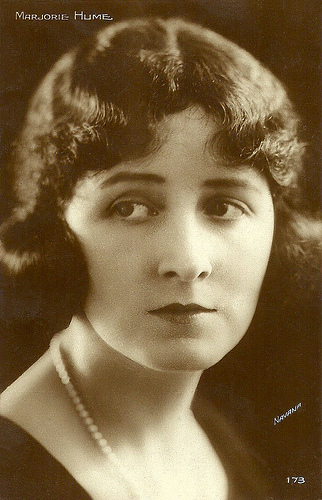
French postcard by Cinémagazine, no. 173. Photo: Navana.
The Call of Youth
Marjorie (also: Marjory) Hume was born in 1893 in Gorleston, Great Yarmouth, United Kingdom, in 1893. ( Wikipedia and IMDb both give a birth year of 1900, but according to The Hitchcock Zone her birth was registered Q1 1893.) She was the daughter of Captain Arthur Hume and Violet Margaret Isabel Hume.
Maejorie started her film career with a small part in the Ellen Terry vehicle Her Greatest Performance (Fred Paul, 1917). In this crime film, Terry played a retired actress who poses as a dresser to scare a murderer into confessing and clearing her son.
Immediately after this, Hume played the female lead - a girl - in the Doing his bit (Edwin J. Collins, 1917). In this comedy written by and starring the cross dressing star George Robey, Robey played an Army reject, who poses as a woman and becomes a nurse.
This was followed by parts in the dramas The Red Pottage (Meyrick Milton, 1918) starring C. Aubrey Smith , The Swindler (Maurice Elvey, 1919), and Keeper of the Door (Maurice Elvey, 1919).
Hume really peaked in the early 1920s with leading roles in the sports film The Scarlett Kiss (Fred Goodwins, 1920), the romance The Duchess of Seven Dials (Fred Paul, 1920), the drama Lady Tetley's Decree (Fred Paul, 1920), the Dutch-British romance Kitty Tailleur (Frank Richardson, 1921), and the drama Bluff (Geoffrey Mahlins, 1921).
Then she played in two Anglo-American coproductions, The Call of Youth (Hugh Ford, 1921) and The Great Day (Hugh Ford, 1921). Both were made in collaboration with Famous Players-Lasky. Alfred Hitchcock is credited as the title designer for both films.
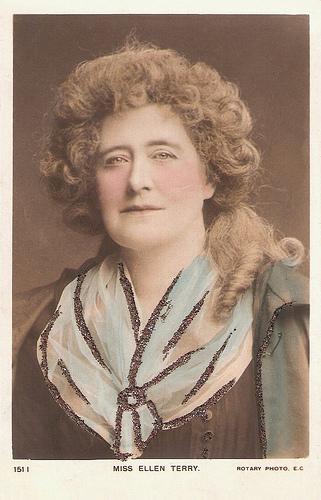
Ellen Terry . British postcard by Rotary Photo, no. 151 I
The Triumph of the Scarlet Pimpernel
Marjorie Hume appeared in the drama Appearances (Donald Crisp, 1921; now considered a lost film), the fantasy mystery Silent Evidence (E.H. Calvert, 1922), and the Lord Byron biopic A Prince of Lovers (Charles Calvert, 1922).
Then followed the historical drama Simone Evrard; or Deathless Devotion (Edwin Greenwood, 1923) and the adventure film M'Lord of the White Road (Arthur Rooke, 1923) starring Victor McLaglen .
In France, she appeared in the melodrama Les deux gosses/Two Little Vagabonds (Louis Mercanton, 1924) with Carlyle Blackwell and Gabriel Signoret .
Back in England, she starred in The Wonderful Wooing (Geoffrey Mahlins, 1925), The Squire of Long Hadley (Sinclair Hill, 1925) with Brian Aherne , and King of the Castle (Henry Edwards, 1925) again with Aherne.
The following years, she made Thou Fool (Fred Paul, 1926) with Stewart Rome , The Island of Despair (Henry Edwards, 1926) with Matheson Lang , and One Colombo Night (Henry Edwards, 1926).
Her last silent films were the comedy The Mariage Business (Leslie Hiscott, 1927) with Estelle Brody, Afterwards (Lawson Butt, 1928), and The Triumph of the Scarlet Pimpernel (T. Hayes Hunter, 1928) with Matheson Lang .
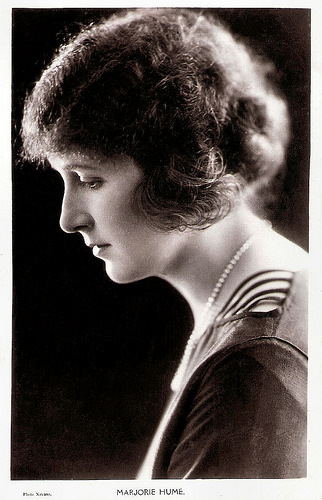
British postcard in the Picturegoer Series, London, no. 130. Photo: Navana.
The Curse of Frankenstein
Marjorie Hume's first sound film was the drama Lord Richard in the Pantry (Walter Forde, 1930) starring Richard Cooper. In 1931 she played opposite former silent stars Stewart Rome and Warwick Ward in the crime film Deadlock (George King, 1931), followed by the crime film Betrayal (Reginald Fogwell, 1932), again with Rome in the male lead.
Next came the Ralph Lynn comedy Up to the Neck (Jack Travers, 1933), the drama A Royal Demand (Gustav Mindzenti, 1933), a small part in the mystery film The White Lilac (Albert Parker, 1935), Cross Currents (Adrian Brunel, 1935), and the crime film Member of the Jury (Bernard Mainwaring, 1937).
From the late 1930s to the early 1950s Marjorie Hume did not perform in film. After the war she returned in small parts, as the landlady in the spy story The Limping Man (Cy Endfield, Charles de la Tour, 1953) starring Lloyd Bridges, and as Lady Redscarfe in the comedy Children Galore (Terence Fisher, 1955).
Marjorie Hume's last film role was an uncredited part as the Mother in the successful Hammer production The Curse of Frankenstein (Terence Fisher, 1957) starring Peter Cushing and Christopher Lee .
In 1976, Marjorie Hume died in Oxshott, United Kingdom. She was married to Eric Lindsey.
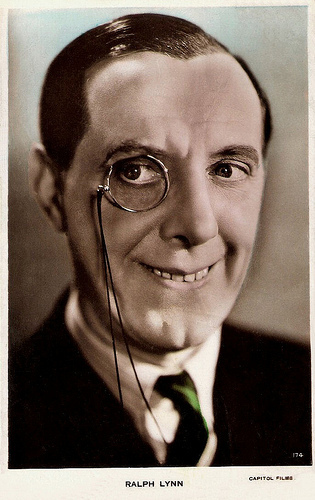
Ralph Lynn . British postcard, no. 174. Photo: Capitol Films.
Sources: Thomas Staedeli (Cyranos), The Hitchcock Zone, Getty Images, Wikipedia, and .

French postcard by Cinémagazine, no. 173. Photo: Navana.
The Call of Youth
Marjorie (also: Marjory) Hume was born in 1893 in Gorleston, Great Yarmouth, United Kingdom, in 1893. ( Wikipedia and IMDb both give a birth year of 1900, but according to The Hitchcock Zone her birth was registered Q1 1893.) She was the daughter of Captain Arthur Hume and Violet Margaret Isabel Hume.
Maejorie started her film career with a small part in the Ellen Terry vehicle Her Greatest Performance (Fred Paul, 1917). In this crime film, Terry played a retired actress who poses as a dresser to scare a murderer into confessing and clearing her son.
Immediately after this, Hume played the female lead - a girl - in the Doing his bit (Edwin J. Collins, 1917). In this comedy written by and starring the cross dressing star George Robey, Robey played an Army reject, who poses as a woman and becomes a nurse.
This was followed by parts in the dramas The Red Pottage (Meyrick Milton, 1918) starring C. Aubrey Smith , The Swindler (Maurice Elvey, 1919), and Keeper of the Door (Maurice Elvey, 1919).
Hume really peaked in the early 1920s with leading roles in the sports film The Scarlett Kiss (Fred Goodwins, 1920), the romance The Duchess of Seven Dials (Fred Paul, 1920), the drama Lady Tetley's Decree (Fred Paul, 1920), the Dutch-British romance Kitty Tailleur (Frank Richardson, 1921), and the drama Bluff (Geoffrey Mahlins, 1921).
Then she played in two Anglo-American coproductions, The Call of Youth (Hugh Ford, 1921) and The Great Day (Hugh Ford, 1921). Both were made in collaboration with Famous Players-Lasky. Alfred Hitchcock is credited as the title designer for both films.

Ellen Terry . British postcard by Rotary Photo, no. 151 I
The Triumph of the Scarlet Pimpernel
Marjorie Hume appeared in the drama Appearances (Donald Crisp, 1921; now considered a lost film), the fantasy mystery Silent Evidence (E.H. Calvert, 1922), and the Lord Byron biopic A Prince of Lovers (Charles Calvert, 1922).
Then followed the historical drama Simone Evrard; or Deathless Devotion (Edwin Greenwood, 1923) and the adventure film M'Lord of the White Road (Arthur Rooke, 1923) starring Victor McLaglen .
In France, she appeared in the melodrama Les deux gosses/Two Little Vagabonds (Louis Mercanton, 1924) with Carlyle Blackwell and Gabriel Signoret .
Back in England, she starred in The Wonderful Wooing (Geoffrey Mahlins, 1925), The Squire of Long Hadley (Sinclair Hill, 1925) with Brian Aherne , and King of the Castle (Henry Edwards, 1925) again with Aherne.
The following years, she made Thou Fool (Fred Paul, 1926) with Stewart Rome , The Island of Despair (Henry Edwards, 1926) with Matheson Lang , and One Colombo Night (Henry Edwards, 1926).
Her last silent films were the comedy The Mariage Business (Leslie Hiscott, 1927) with Estelle Brody, Afterwards (Lawson Butt, 1928), and The Triumph of the Scarlet Pimpernel (T. Hayes Hunter, 1928) with Matheson Lang .

British postcard in the Picturegoer Series, London, no. 130. Photo: Navana.
The Curse of Frankenstein
Marjorie Hume's first sound film was the drama Lord Richard in the Pantry (Walter Forde, 1930) starring Richard Cooper. In 1931 she played opposite former silent stars Stewart Rome and Warwick Ward in the crime film Deadlock (George King, 1931), followed by the crime film Betrayal (Reginald Fogwell, 1932), again with Rome in the male lead.
Next came the Ralph Lynn comedy Up to the Neck (Jack Travers, 1933), the drama A Royal Demand (Gustav Mindzenti, 1933), a small part in the mystery film The White Lilac (Albert Parker, 1935), Cross Currents (Adrian Brunel, 1935), and the crime film Member of the Jury (Bernard Mainwaring, 1937).
From the late 1930s to the early 1950s Marjorie Hume did not perform in film. After the war she returned in small parts, as the landlady in the spy story The Limping Man (Cy Endfield, Charles de la Tour, 1953) starring Lloyd Bridges, and as Lady Redscarfe in the comedy Children Galore (Terence Fisher, 1955).
Marjorie Hume's last film role was an uncredited part as the Mother in the successful Hammer production The Curse of Frankenstein (Terence Fisher, 1957) starring Peter Cushing and Christopher Lee .
In 1976, Marjorie Hume died in Oxshott, United Kingdom. She was married to Eric Lindsey.

Ralph Lynn . British postcard, no. 174. Photo: Capitol Films.
Sources: Thomas Staedeli (Cyranos), The Hitchcock Zone, Getty Images, Wikipedia, and .
Published on August 24, 2015 22:00
August 23, 2015
Vladimir Maksimov
Elegant Vladimir Maksimov (1880-1937) was one of the most popular film stars of the Russian empire. After the revolution he became known known for the Soviet films Skorb beskonechnaya/Infinite Sorrow (Aleksandr Panteleyev, 1922), Katsi katsistvis mgelia/Man Is Enemy (Ivane Perestiani, 1923) and Dekabristy/The Decembrists (Aleksandr Ivanovsky, 1927).
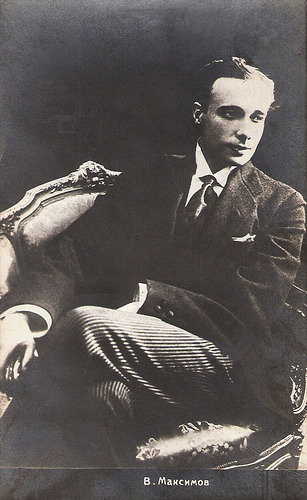
Russian postcard. Sent by mail in Estonia in 1922.
At Midnight in the Graveyard
Vladimir Vasilievich Maksimov (Russian: Владимир Васильевич Максимов) was born in Moscow in the Russian Empire in 1880. His mother was a singing teacher.
Maksimov started his stage career in 1904 at the Moscow Art Theatre under the direction of K. Stanislavsky and V. Nemirovich-Danchenko. Among his roles was Konstantin in The Seagull by Anton Chekhov. From 1906 to 1918, he performed at the Maly Theatre.
In 1910 he made his film debut opposite Ivan Mozzhukin for the Khanzhonkov production company in V polnoch na kladbishche/At Midnight in the Graveyard (Vasily Goncharov, 1910). In this short silent horror film two men are betting about who is to visit a Paris cemetery at midnight. The visit turns out to be fatal.
Next he played for Khanzhonkov in Oborona Sevastopolya/Defence of Sebastopol (Vasili Goncharov, Aleksandr Khanzhonkov, 1911), the first film ever shot by two cameras. Set in 1854-1855, in Sebastopol and Yalta during the Crimean War. Admirals Kornilov ( Ivan Mozzhukin ) and Nakhimov (Andrej Gromov) organize the defense during the siege of Sebastopol. Both admirals are killed during the battle, and the city of Sebastopol is taken by the alliance of British, French, Sardinian, and Turkish troops.
The legendary feat of Sailor Koshka (N. Semyonov) was staged at original location. Veterans of the Crimean War of 1854-1855 took part in the film production. With 100 minutes, it was Russia's first full-length feature film. Oborona Sevastopolya/Defence of Sebastopol was premiered in 1911 at the Livadia, Yalta, palace for the Tsar Nicholas II, who was the main sponsor of this production.
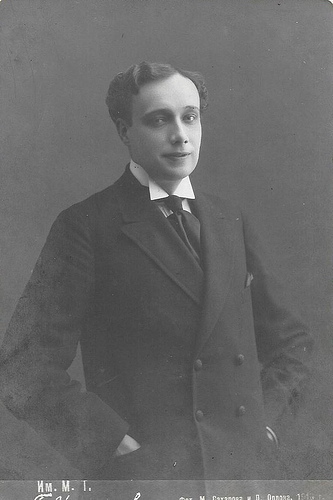
Russian postcard. Collection: Didier Hanson.
The elegantly dressed, romantic lover
Till the end of World War I, Vladimir Maksimov starred in many silent films, including the drama Anfisa (Yakov Protazanov, 1912), the German film Das Haus ohne Tür/The House without a Door (Stellan Rye, 1914) with Theodoor Loos , and Peterburgskiye trushchobi/Petersburg Slums (Petr Cardynin a.k.a. Pyotr Chardynin, Vladimir Gardin, Yakov Protazanov, 1915).
Often playing the elegantly dressed, romantic lover, Maksimov became one of the most popular Russian actors of his era. In 1915 and 1917 he also directed some films.
Maksimov was one of the stars in the cast of the silent drama Molchi, grust... molchi/Молчи, грусть...молчи/Be silent, sorrow ... be silent (Petr Cardynin a.k.a. Pyotr Chardynin, 1918) as Volyntsev, an artist, opposite Vera Kholodnaya , Ossip Runitsch and Vitold Polonsky . This film consisted of two parts, but only the first part (44 minutes in length) survives.
After the Russian revolution, Maksimov appeared in Soviet films like Skorb beskonechnaya/Infinite Sorrow (Aleksandr Panteleyev, 1922), Katsi katsistvis mgelia/Man Is Enemy (Ivane Perestiani, 1923) as Kraev, Slesar i kantsler/Locksmith and Chancellor (Vladimir Gardin, 1923) as the lawyer Frank Frey. His last part was as Alexander in Dekabristy/The Decembrists (Aleksandr Ivanovsky, 1927). From 1919 to 1924, he was also one of the organizers of the Bolshoi Drama Theatre.
Since 1924, he taught at the Leningrad Institute of Performing Arts. In 1925, the Soviet Union honoured him as 'Artist of the State'. Vladimir Maksimov died in 1937 in Moscow, Soviet Union. He was 56 or 57 (the two Wikipedia sources differ about his age).
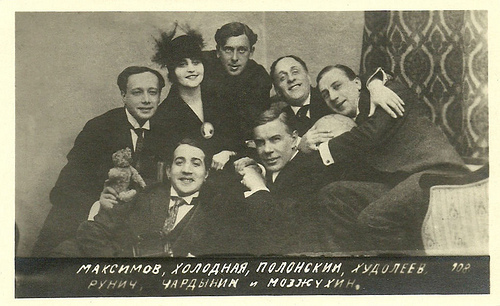
Russian postcard, no. 108. Collection: Didier Hanson. A Who is Who of the Russian silent cinema. In a circle from left: actor Vladimir Maksimov (with bear), actress Vera Kholodnaya , actor Vitold Polonsky , actor Ivan Khudoleyev, actor Ivan Mozzhukin , actor-director Petr Cardynin and actor Ossip Runitsch .
Source: Wikipedia (French, Russian and English), and .

Russian postcard. Sent by mail in Estonia in 1922.
At Midnight in the Graveyard
Vladimir Vasilievich Maksimov (Russian: Владимир Васильевич Максимов) was born in Moscow in the Russian Empire in 1880. His mother was a singing teacher.
Maksimov started his stage career in 1904 at the Moscow Art Theatre under the direction of K. Stanislavsky and V. Nemirovich-Danchenko. Among his roles was Konstantin in The Seagull by Anton Chekhov. From 1906 to 1918, he performed at the Maly Theatre.
In 1910 he made his film debut opposite Ivan Mozzhukin for the Khanzhonkov production company in V polnoch na kladbishche/At Midnight in the Graveyard (Vasily Goncharov, 1910). In this short silent horror film two men are betting about who is to visit a Paris cemetery at midnight. The visit turns out to be fatal.
Next he played for Khanzhonkov in Oborona Sevastopolya/Defence of Sebastopol (Vasili Goncharov, Aleksandr Khanzhonkov, 1911), the first film ever shot by two cameras. Set in 1854-1855, in Sebastopol and Yalta during the Crimean War. Admirals Kornilov ( Ivan Mozzhukin ) and Nakhimov (Andrej Gromov) organize the defense during the siege of Sebastopol. Both admirals are killed during the battle, and the city of Sebastopol is taken by the alliance of British, French, Sardinian, and Turkish troops.
The legendary feat of Sailor Koshka (N. Semyonov) was staged at original location. Veterans of the Crimean War of 1854-1855 took part in the film production. With 100 minutes, it was Russia's first full-length feature film. Oborona Sevastopolya/Defence of Sebastopol was premiered in 1911 at the Livadia, Yalta, palace for the Tsar Nicholas II, who was the main sponsor of this production.

Russian postcard. Collection: Didier Hanson.
The elegantly dressed, romantic lover
Till the end of World War I, Vladimir Maksimov starred in many silent films, including the drama Anfisa (Yakov Protazanov, 1912), the German film Das Haus ohne Tür/The House without a Door (Stellan Rye, 1914) with Theodoor Loos , and Peterburgskiye trushchobi/Petersburg Slums (Petr Cardynin a.k.a. Pyotr Chardynin, Vladimir Gardin, Yakov Protazanov, 1915).
Often playing the elegantly dressed, romantic lover, Maksimov became one of the most popular Russian actors of his era. In 1915 and 1917 he also directed some films.
Maksimov was one of the stars in the cast of the silent drama Molchi, grust... molchi/Молчи, грусть...молчи/Be silent, sorrow ... be silent (Petr Cardynin a.k.a. Pyotr Chardynin, 1918) as Volyntsev, an artist, opposite Vera Kholodnaya , Ossip Runitsch and Vitold Polonsky . This film consisted of two parts, but only the first part (44 minutes in length) survives.
After the Russian revolution, Maksimov appeared in Soviet films like Skorb beskonechnaya/Infinite Sorrow (Aleksandr Panteleyev, 1922), Katsi katsistvis mgelia/Man Is Enemy (Ivane Perestiani, 1923) as Kraev, Slesar i kantsler/Locksmith and Chancellor (Vladimir Gardin, 1923) as the lawyer Frank Frey. His last part was as Alexander in Dekabristy/The Decembrists (Aleksandr Ivanovsky, 1927). From 1919 to 1924, he was also one of the organizers of the Bolshoi Drama Theatre.
Since 1924, he taught at the Leningrad Institute of Performing Arts. In 1925, the Soviet Union honoured him as 'Artist of the State'. Vladimir Maksimov died in 1937 in Moscow, Soviet Union. He was 56 or 57 (the two Wikipedia sources differ about his age).

Russian postcard, no. 108. Collection: Didier Hanson. A Who is Who of the Russian silent cinema. In a circle from left: actor Vladimir Maksimov (with bear), actress Vera Kholodnaya , actor Vitold Polonsky , actor Ivan Khudoleyev, actor Ivan Mozzhukin , actor-director Petr Cardynin and actor Ossip Runitsch .
Source: Wikipedia (French, Russian and English), and .
Published on August 23, 2015 22:00
August 22, 2015
Max Dearly
Max Dearly (1874-1943) was a French character actor, famous for his parts in French film classics of the 1930s. However, Dearly was above all an excellent actor in vaudeville and revues.
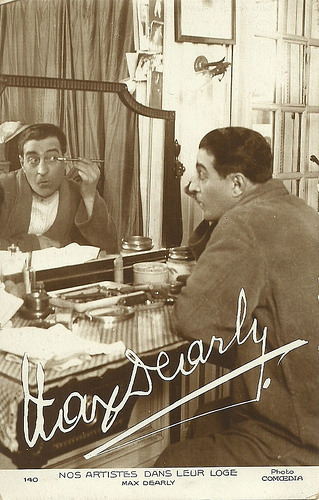
French postcard by Editions La Fayette, Paris, in the series Nos artistes dans leur loge, no. 140. Photo: Comoedia.
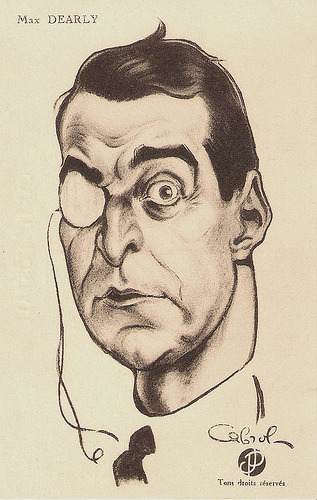
French postcard by Publications J.P., Paris, no. 7. Illustration: Cabrol.
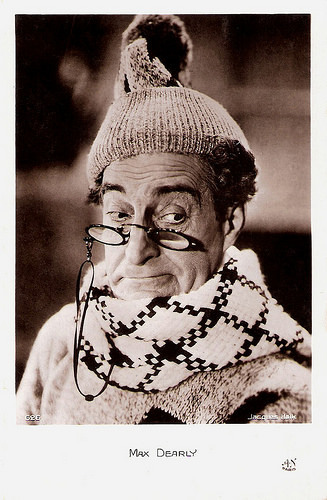
French postcard by A.N., Paris, no. 626. Photo: Jacques Haik.
Letting the audience have peals of laughter
Max Dearly was born as Lucien Paul Marie-Joseph Rolland in Paris in 1874. He made his stage debut in 1891.
Between ca. 1903 and the outbreak of the First World War, Max Dearly excelled at the Théâtre des Variétés in vaudeville and revues by Paul Gavault (Paris aux Variétés, 1903; La Revue du centenaire, 1907), Robert de Flers et Gaston Arman de Caillavet, Paul Gavault (Miquette et sa mère, 1906; Le Roi, 1908; Le Bois sacré, 1910), Alfred Capus (Un ange, 1910; Les Favorites, 1911) and others.
Around 1906 Dearly also performed at the Moulin Rouge with the famous singer and dancer Mistinguett in a revue called La valse chaloupe (The Swinging, Swaying Waltz), in which Parisian low-life and the worlds of the ‘apaches’ was performed. Postcards but also work by the Dutch painter Kees van Dongen still testify of this.
After the First World War Dearly alternated his work at the Théâtre des Variétés with other Parisian theatres such as Théâtre de Paris, Théâtre des Nouveautés, Théâtre du Palais-Royal, Théâtre Edouard VII, and Théâtre Antoine. Popular was L'École des cocottes by Paul Armont and Marcel Gerbidon, in which Dearly had the lead both in 1920 and 1923, opposite later famous film actors like Raimu and Arletty .
At his death in 1943, Léo Marchès wrote a posthumous tribute to Max Dearly for the newspaper Le Matin. Dearly was the last of the big band of the still existing Théâtre des Variétés, which between 1892 to 1914 attracted the whole of Paris, under the guidance of Fernand Samuel, 'Samuel the Magnificent', who at the boulevard Montmartre, had gathered a group that excelled both in comedy and operetta, e.g. Jeanne Gruat, Eve Lavallière, Lender, Dupuis, Albert Brasseur, Guy Gallois and his wife Germaine Gallois, Diéterle, and Max Dearly.
Dearly was an important player amidst this gang. Words were attributed to him that not always originated from his performances, while he also invented adventures which people loved. While Marchès claimed his marriage with actress Jane Saint-Bonnet, also part of the troupe of Variétés, was a model of fidelity, this contrasts with Dearly’s previous reputation of womanizer, which was the cause of the break-up with his first wife, Isabelle-Eugénie Fusier, daughter of drama actor Léon Fusier, whom he married in 1911. She was 18, he 37. Already in February 1912 the marriage ended in divorce, as Dearly had to recognize his infidelities. He was sentenced to pay his ex 800 francs per month.
When analysing comedy acting in France, literary and theatre critic Jules Lemaître wrote that three actors were absolutely outstanding, as they were able even unprepared to let the audience have peals of laughter because of their imagination and phantasy: Albert Brasseur, Galipaux et Max Dearly. About the same time, renowned stage wright Robert de Flers, claimed that Dearly was not just successful because of the plays De Flers and Caillavet had written: “It is his Dearly himself, you’ll notice it when seeing him act opposite others.”
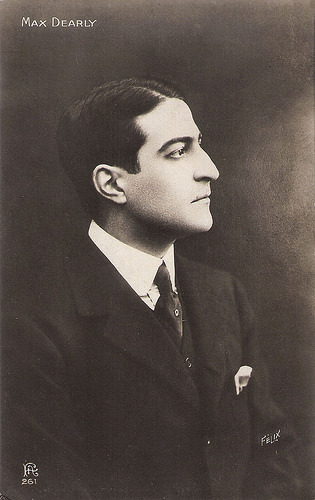
French postcard by F.A., Paris, no. 261. Photo: Félix.
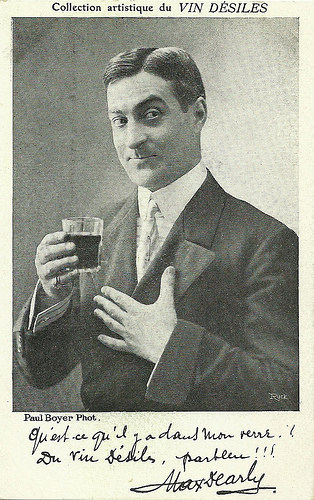
French postcard. Photo: Paul Boyer / Ruck. Caption: Qu'est-ce qu'il y a dans mon verre? Du Vin Désiles, parbleu!!! (What's that in my glass? Its is Désiles wine, parbleu!!!).
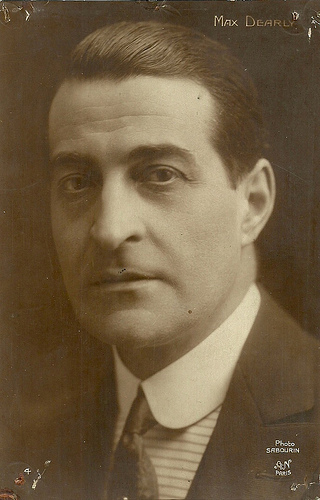
French postcard by A.N., Paris, no. 4. Photo: Sabourin.
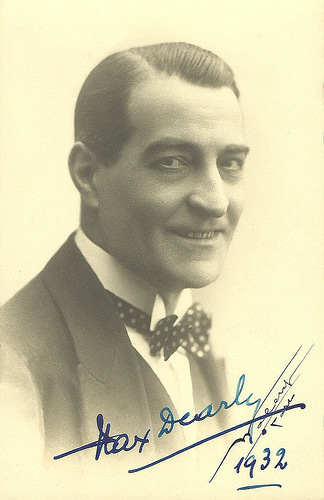
French postcard. Signed in 1932. Collection: Didier Hanson.
The richest man on earth
Before 1910, Max Dearly already acted in Film d’art films such as L’Empreinte (Henri Burguet, 1908) and Carmen (André Calmettes, 1908). But he had his real breakthrough as film actor with the arrival of sound cinema in France. His first part was in Azaïs (René Hervil, 1931), an adaptation of a play by Louis Verneuil and Georges Berr in which Dearly had performed in 1930 at the Théâtre Edouard VII.
René Hervil had been a routiné of silent film directing in France, mainly comedy but also drama. After that followed leads in Coquecigrole (André Berthomieu, 1931), the film operetta Coups de roullis (Pierre de la Cour, 1932), and L’Amour et la veine (Monty Banks, 1932) – the French language version of Money for Nothing.
In 1933 Dearly played the pharmacist Homais in Jean Renoir’s adaptation of Gustave Flaubert’s Madame Bovary. Memorable was also his part as the eccentric aristocrat Mr. Gillenormand, Marius’ grandfather in Les Misérables (Raymond Bernard, 1934). Dearly acted opposite Harry Baur as Jean Valjean, Jean Servais as Marius and Josseline Gael as Cosette.
Dearly was hilarious in René Clair’s Le Dernier Milliardaire/The Last Billionaire (1934) as Mr Banco, the richest man on earth, who basically becomes the dictator of Casinario, a fictional small European kingdom which is on the verge of going broke. While losing reason after a knock on the head, he orders the most stupid decretes which the people and elite of Casinario still accept as common sense.
After Arlette et ses papas (Henry Roussel, 1934), Dearly played M. Maubert opposite Fernand Gravey and Mireille Balin in Richard Pottier’s Si j'étais le patron (1934). In 1935 he had the lead in Pottier’s Un oiseau rare, based on a novel by Erich Kästner, Three men in the snow, and scripted by Jacques Prévert. It is a comedy of changing trades between a master and a valet and winning a winter sports holiday. It co-starred Pierre Brasseur , Monique Rolland and Pierre Larquey.
After Paris Camargue (Jack Forrester 1935), Dearly had again the lead as Ramiro Mendoza in La Vie Parisienne/Parisian Life (1936) by German émigré director Robert Siodmak a. It was scripted by Marcel Carné, Michel Carré, Emeric Pressburger and Benno Vigny and adapted from the operetta by Ludovic Halévy and Henri Meilhac. Dearly played a Brazilian business man who opposes his daughter’s ( Concita Montenegro ) marriage with a Parisian (Georges Rigaud). His father and a former operetta diva with whom he had had an affair with in the past, convert him to ‘Parisian Life’. A separate English-language version was also produced. The film was not a success, causing financial problems for the production company, Nero Film, run by the émigré producer Seymour Nebenzal.
Then, Dearly played Blanchette Brunoy ’s neglecting father in the comedy Claudine à l’école (Serge de Poligny, 1937), after Colette. After other secondary parts as in Le Train pour Venise (André Berthomieu, 1938) starring Louis Verneuil on whose play the film was based. Dearly had again a lead in Christian-Jaque’s Le Grand Élan (1939), about a real estate owner who wants to buy a bankrupt hotel for a low price. The film was released in Paris in December 1940, when the city was already occupied by the nazi’s.
In the meantime Dearly had also acted in Sacha Guitry ’s comedy Ils étaient neuf célibataires/Nine Bachelors (1939) in which foreign women threatened to be exiled marry for fake with old clochards. His last, supporting parts in film, Dearly played in Bécassine (Pierre Caron, 1940) and Le Club des soupirants (Maurice Gleize, 1941). Max Dearly died in Neuilly-sur-Seine in 1943 and lies buried at the cemetery of Montparnasse. Dearly was responsible for the foundation of the Gala de l'Union des artistes, founded in 1923 to help artists in trouble.
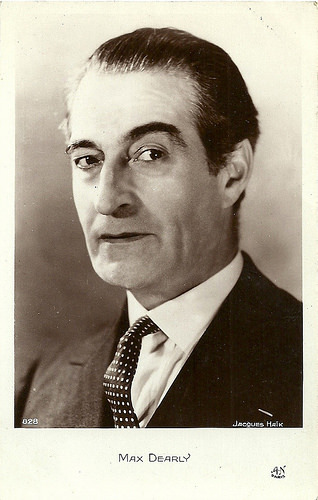
French postcard by A.N. Paris, no. 828. Photo: Jacques Haïk.
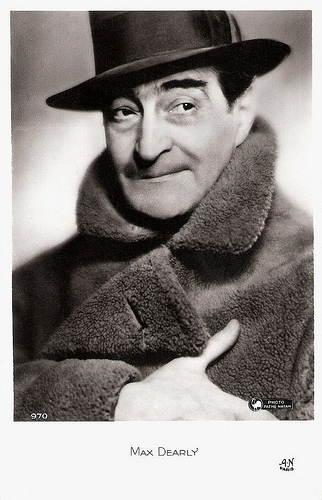
French postcard by A.N., Paris, no. 970. Photo: Pathé Natan.
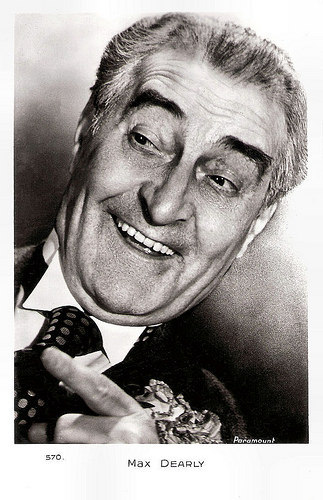
French postcard by Editions Chantal, Paris, no. 570. Photo: Paramount.
Sources: Léo Marchès (Hommage posthume à Max Dearly, Le Matin, 9 June 1943 - French), Du temps des cerises aux feuilles mortes (French), Wikipedia (French and English) and .

French postcard by Editions La Fayette, Paris, in the series Nos artistes dans leur loge, no. 140. Photo: Comoedia.

French postcard by Publications J.P., Paris, no. 7. Illustration: Cabrol.

French postcard by A.N., Paris, no. 626. Photo: Jacques Haik.
Letting the audience have peals of laughter
Max Dearly was born as Lucien Paul Marie-Joseph Rolland in Paris in 1874. He made his stage debut in 1891.
Between ca. 1903 and the outbreak of the First World War, Max Dearly excelled at the Théâtre des Variétés in vaudeville and revues by Paul Gavault (Paris aux Variétés, 1903; La Revue du centenaire, 1907), Robert de Flers et Gaston Arman de Caillavet, Paul Gavault (Miquette et sa mère, 1906; Le Roi, 1908; Le Bois sacré, 1910), Alfred Capus (Un ange, 1910; Les Favorites, 1911) and others.
Around 1906 Dearly also performed at the Moulin Rouge with the famous singer and dancer Mistinguett in a revue called La valse chaloupe (The Swinging, Swaying Waltz), in which Parisian low-life and the worlds of the ‘apaches’ was performed. Postcards but also work by the Dutch painter Kees van Dongen still testify of this.
After the First World War Dearly alternated his work at the Théâtre des Variétés with other Parisian theatres such as Théâtre de Paris, Théâtre des Nouveautés, Théâtre du Palais-Royal, Théâtre Edouard VII, and Théâtre Antoine. Popular was L'École des cocottes by Paul Armont and Marcel Gerbidon, in which Dearly had the lead both in 1920 and 1923, opposite later famous film actors like Raimu and Arletty .
At his death in 1943, Léo Marchès wrote a posthumous tribute to Max Dearly for the newspaper Le Matin. Dearly was the last of the big band of the still existing Théâtre des Variétés, which between 1892 to 1914 attracted the whole of Paris, under the guidance of Fernand Samuel, 'Samuel the Magnificent', who at the boulevard Montmartre, had gathered a group that excelled both in comedy and operetta, e.g. Jeanne Gruat, Eve Lavallière, Lender, Dupuis, Albert Brasseur, Guy Gallois and his wife Germaine Gallois, Diéterle, and Max Dearly.
Dearly was an important player amidst this gang. Words were attributed to him that not always originated from his performances, while he also invented adventures which people loved. While Marchès claimed his marriage with actress Jane Saint-Bonnet, also part of the troupe of Variétés, was a model of fidelity, this contrasts with Dearly’s previous reputation of womanizer, which was the cause of the break-up with his first wife, Isabelle-Eugénie Fusier, daughter of drama actor Léon Fusier, whom he married in 1911. She was 18, he 37. Already in February 1912 the marriage ended in divorce, as Dearly had to recognize his infidelities. He was sentenced to pay his ex 800 francs per month.
When analysing comedy acting in France, literary and theatre critic Jules Lemaître wrote that three actors were absolutely outstanding, as they were able even unprepared to let the audience have peals of laughter because of their imagination and phantasy: Albert Brasseur, Galipaux et Max Dearly. About the same time, renowned stage wright Robert de Flers, claimed that Dearly was not just successful because of the plays De Flers and Caillavet had written: “It is his Dearly himself, you’ll notice it when seeing him act opposite others.”

French postcard by F.A., Paris, no. 261. Photo: Félix.

French postcard. Photo: Paul Boyer / Ruck. Caption: Qu'est-ce qu'il y a dans mon verre? Du Vin Désiles, parbleu!!! (What's that in my glass? Its is Désiles wine, parbleu!!!).

French postcard by A.N., Paris, no. 4. Photo: Sabourin.

French postcard. Signed in 1932. Collection: Didier Hanson.
The richest man on earth
Before 1910, Max Dearly already acted in Film d’art films such as L’Empreinte (Henri Burguet, 1908) and Carmen (André Calmettes, 1908). But he had his real breakthrough as film actor with the arrival of sound cinema in France. His first part was in Azaïs (René Hervil, 1931), an adaptation of a play by Louis Verneuil and Georges Berr in which Dearly had performed in 1930 at the Théâtre Edouard VII.
René Hervil had been a routiné of silent film directing in France, mainly comedy but also drama. After that followed leads in Coquecigrole (André Berthomieu, 1931), the film operetta Coups de roullis (Pierre de la Cour, 1932), and L’Amour et la veine (Monty Banks, 1932) – the French language version of Money for Nothing.
In 1933 Dearly played the pharmacist Homais in Jean Renoir’s adaptation of Gustave Flaubert’s Madame Bovary. Memorable was also his part as the eccentric aristocrat Mr. Gillenormand, Marius’ grandfather in Les Misérables (Raymond Bernard, 1934). Dearly acted opposite Harry Baur as Jean Valjean, Jean Servais as Marius and Josseline Gael as Cosette.
Dearly was hilarious in René Clair’s Le Dernier Milliardaire/The Last Billionaire (1934) as Mr Banco, the richest man on earth, who basically becomes the dictator of Casinario, a fictional small European kingdom which is on the verge of going broke. While losing reason after a knock on the head, he orders the most stupid decretes which the people and elite of Casinario still accept as common sense.
After Arlette et ses papas (Henry Roussel, 1934), Dearly played M. Maubert opposite Fernand Gravey and Mireille Balin in Richard Pottier’s Si j'étais le patron (1934). In 1935 he had the lead in Pottier’s Un oiseau rare, based on a novel by Erich Kästner, Three men in the snow, and scripted by Jacques Prévert. It is a comedy of changing trades between a master and a valet and winning a winter sports holiday. It co-starred Pierre Brasseur , Monique Rolland and Pierre Larquey.
After Paris Camargue (Jack Forrester 1935), Dearly had again the lead as Ramiro Mendoza in La Vie Parisienne/Parisian Life (1936) by German émigré director Robert Siodmak a. It was scripted by Marcel Carné, Michel Carré, Emeric Pressburger and Benno Vigny and adapted from the operetta by Ludovic Halévy and Henri Meilhac. Dearly played a Brazilian business man who opposes his daughter’s ( Concita Montenegro ) marriage with a Parisian (Georges Rigaud). His father and a former operetta diva with whom he had had an affair with in the past, convert him to ‘Parisian Life’. A separate English-language version was also produced. The film was not a success, causing financial problems for the production company, Nero Film, run by the émigré producer Seymour Nebenzal.
Then, Dearly played Blanchette Brunoy ’s neglecting father in the comedy Claudine à l’école (Serge de Poligny, 1937), after Colette. After other secondary parts as in Le Train pour Venise (André Berthomieu, 1938) starring Louis Verneuil on whose play the film was based. Dearly had again a lead in Christian-Jaque’s Le Grand Élan (1939), about a real estate owner who wants to buy a bankrupt hotel for a low price. The film was released in Paris in December 1940, when the city was already occupied by the nazi’s.
In the meantime Dearly had also acted in Sacha Guitry ’s comedy Ils étaient neuf célibataires/Nine Bachelors (1939) in which foreign women threatened to be exiled marry for fake with old clochards. His last, supporting parts in film, Dearly played in Bécassine (Pierre Caron, 1940) and Le Club des soupirants (Maurice Gleize, 1941). Max Dearly died in Neuilly-sur-Seine in 1943 and lies buried at the cemetery of Montparnasse. Dearly was responsible for the foundation of the Gala de l'Union des artistes, founded in 1923 to help artists in trouble.

French postcard by A.N. Paris, no. 828. Photo: Jacques Haïk.

French postcard by A.N., Paris, no. 970. Photo: Pathé Natan.

French postcard by Editions Chantal, Paris, no. 570. Photo: Paramount.
Sources: Léo Marchès (Hommage posthume à Max Dearly, Le Matin, 9 June 1943 - French), Du temps des cerises aux feuilles mortes (French), Wikipedia (French and English) and .
Published on August 22, 2015 22:00
August 21, 2015
Die Geyer-Wally (1921)
Henny Porten was one of the three brightest female stars of the silent Weimar cinema - the others were Asta Nielsen and Fern Andra. One of her success films was Die Geyer-Wally/Vulture Wally (E.A. Dupont, 1921), an atmospheric Alpine melodrama in which she played the free-spirited mountain girl Wally.
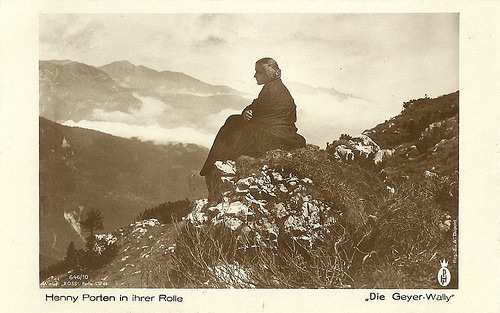
German postcard by Ross Verlag, no. 646/10. Photo: HPF (Henny Porten Film). Henny Porten as Wally in Die Geyer-Wally/Vulture Wally (E.A. Dupont, 1921).
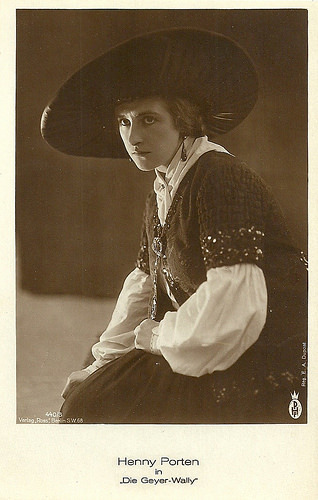
German postcard by Ross Verlag, no. 440/3. Photo: HPF (Henny Porten-Film). Henny Porten in Die Geyer-Wally/Vulture Wally (E.A. Dupont, 1921).
A difficult situation in a nest of vultures
Die Geyer-Wally/Vulture Wally is a 'bergfilm' (mountain film), a melodrama set in the Alps. It is based on a popular novel by Wilhelmine von Hillern.
When farmer daughter Wally ( Henny Porten ) saves Bären-Joseph from a difficult situation in a nest of vultures (Geier in German), she earns the nickname of Geier-Wally.
She falls in love with Bären-Joseph (Bear-Joseph - played by Wilhelm Dieterle a.k.a. Hollywood director William Dieterle) , but her father (Albert Steinrück) wants her to marry Der Gellner-Vincenz (Eugen Klöpfer).
Moreover, Joseph seems to have a secret lover. Wally is outraged when she learns about this and Vincenz even wants to kill him. But in the end it turns out that the 'lover' is Joseph's daughter, born out of wedlock. Wally and Joseph can still marry...
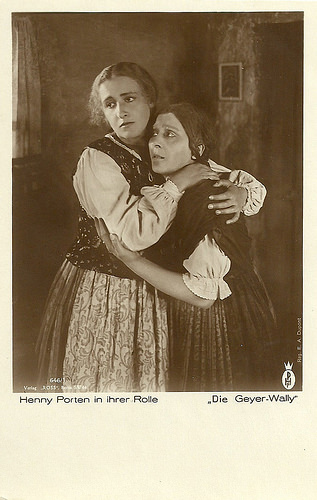
German postcard by Ross Verlag, no. 646/1. Photo: HPF (Henny Porten Film). Henny Porten as Wally in Die Geyer-Wally/Vulture Wally (E.A. Dupont, 1921). The second woman may be Maria Grimm-Einödshofer (Obermagd).
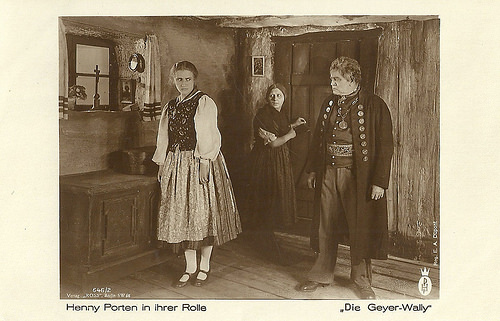
German postcard by Ross Verlag, no. 646/2. Photo: HPF (Henny Porten Film). Henny Porten as Wally in Die Geyer-Wally/Vulture Wally (E.A. Dupont, 1921). Albert Steinrück played her father, Stromminger. The second woman may be Maria Grimm-Einödshofer (Obermagd).
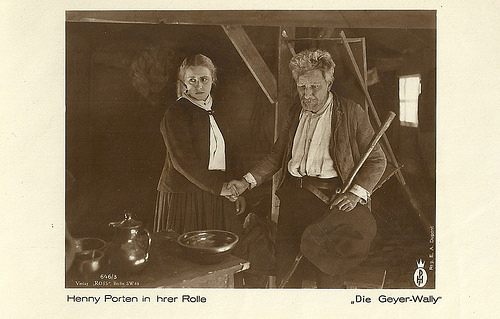
German postcard by Ross Verlag, no. 646/3. Photo: HPF (Henny Porten Film). Henny Porten as Wally in Die Geyer-Wally/Vulture Wally (E.A. Dupont, 1921). The man could be Julius Brandt (Klettenmeyer).
A huge box-office hit
Die Geyer-Wally/Vulture Wally is a typical 'bergfilm' (mountain film), an atmospheric mountain melodrama set in the Alps. In fact it was filmed in Garmisch-Partenkirchen in Bavaria.
Henny Porten was such a popular star at the time that she could produce the film herself. In 1919, Porten had founded her own film company, HPF (Henny Porten Film), which worked for Gloria-Film. The Ufa distributed the film.
Her production company had attracted an accomplished and talented cast and crew. Die Geier-Wally was directed by Ewald André Dupont, who would go on to direct the classic Variété/Variety (1925) and the sets were designed by Paul Leni, who would later become a horrorfilm director for Universal. In 1921, Leni co-directed her also in Hintertreppe/Backstairs (Paul Leni, Leopold Jessner, 1921).
Die Geyer-Wally/Vulture Wally was a huge box-office hit and one of Porten's most successful films of the early 1920s. The story was also the basis of Alfredo Catalani's opera La Wally. In 1930 followed a silent Italian film version, La leggenda di Wally (Gian Orlando Vassallo, 1930) featuring Linda Pini.
Sound versions included the Italian production La Wally (Guido Brignone, 1932) with Germana Paolieri , a second German version Die Geierwally (Hans Steinhoff, 1940) with Heidemarie Hatheyer , and a post-war version, riding the Heimatfilm wave Die Geierwally (Frantisek Cáp, 1956) with Barbara Rütting . Finally, Bavarian director Walter Bockmayer also made a spoof of the classic, Geierwally (1988).
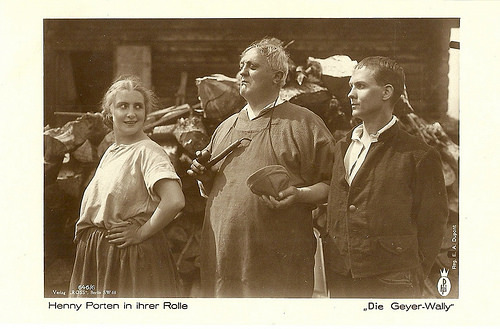
German postcard by Ross Verlag, no. 646/6. Photo: HPF (Henny Porten Film). Henny Porten as Wally in Die Geyer-Wally/Vulture Wally (E.A. Dupont, 1921). Despite the fact that drama and romance dominate, the film has some witty scenes, sich as the one in which Wally rejects the marriage proposal by farmer Rosenbauer senior (Wilhelm Diegelmann) and his son Rosenbauer junior (Gerd Fricke).
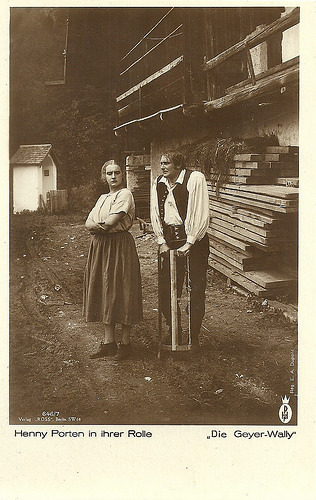
German postcard by Ross Verlag, no. 646/7. Photo: HPF (Henny Porten Film). Henny Porten as Wally and Eugen Klöpfer as Vincenz in Die Geyer-Wally/Vulture Wally (E.A. Dupont, 1921).
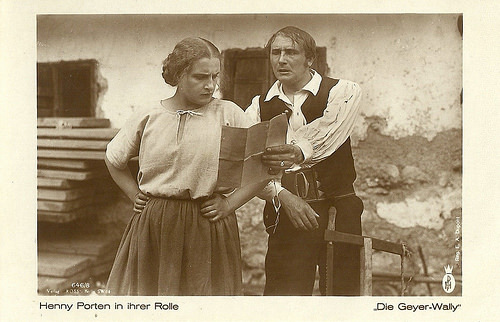
German postcard by Ross Verlag, no. 646/8. Photo: HPF (Henny Porten Film). Henny Porten as Wally and Eugen Klöpfer as Vincenz in Die Geyer-Wally/Vulture Wally (E.A. Dupont, 1921).
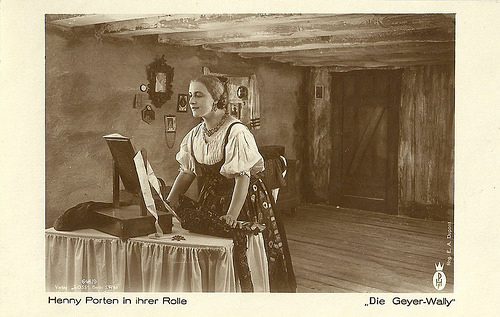
German postcard by Ross Verlag, no. 646/9. Photo: HPF (Henny Porten Film). Henny Porten as Wally in Die Geyer-Wally/Vulture Wally (E.A. Dupont, 1921).
Die Geyer-Wally/Vulture Wally (1921). Source: Paul Greif (YouTube).
Sources: Filmportal.de (German), Wikipedia and IMDb.

German postcard by Ross Verlag, no. 646/10. Photo: HPF (Henny Porten Film). Henny Porten as Wally in Die Geyer-Wally/Vulture Wally (E.A. Dupont, 1921).

German postcard by Ross Verlag, no. 440/3. Photo: HPF (Henny Porten-Film). Henny Porten in Die Geyer-Wally/Vulture Wally (E.A. Dupont, 1921).
A difficult situation in a nest of vultures
Die Geyer-Wally/Vulture Wally is a 'bergfilm' (mountain film), a melodrama set in the Alps. It is based on a popular novel by Wilhelmine von Hillern.
When farmer daughter Wally ( Henny Porten ) saves Bären-Joseph from a difficult situation in a nest of vultures (Geier in German), she earns the nickname of Geier-Wally.
She falls in love with Bären-Joseph (Bear-Joseph - played by Wilhelm Dieterle a.k.a. Hollywood director William Dieterle) , but her father (Albert Steinrück) wants her to marry Der Gellner-Vincenz (Eugen Klöpfer).
Moreover, Joseph seems to have a secret lover. Wally is outraged when she learns about this and Vincenz even wants to kill him. But in the end it turns out that the 'lover' is Joseph's daughter, born out of wedlock. Wally and Joseph can still marry...

German postcard by Ross Verlag, no. 646/1. Photo: HPF (Henny Porten Film). Henny Porten as Wally in Die Geyer-Wally/Vulture Wally (E.A. Dupont, 1921). The second woman may be Maria Grimm-Einödshofer (Obermagd).

German postcard by Ross Verlag, no. 646/2. Photo: HPF (Henny Porten Film). Henny Porten as Wally in Die Geyer-Wally/Vulture Wally (E.A. Dupont, 1921). Albert Steinrück played her father, Stromminger. The second woman may be Maria Grimm-Einödshofer (Obermagd).

German postcard by Ross Verlag, no. 646/3. Photo: HPF (Henny Porten Film). Henny Porten as Wally in Die Geyer-Wally/Vulture Wally (E.A. Dupont, 1921). The man could be Julius Brandt (Klettenmeyer).
A huge box-office hit
Die Geyer-Wally/Vulture Wally is a typical 'bergfilm' (mountain film), an atmospheric mountain melodrama set in the Alps. In fact it was filmed in Garmisch-Partenkirchen in Bavaria.
Henny Porten was such a popular star at the time that she could produce the film herself. In 1919, Porten had founded her own film company, HPF (Henny Porten Film), which worked for Gloria-Film. The Ufa distributed the film.
Her production company had attracted an accomplished and talented cast and crew. Die Geier-Wally was directed by Ewald André Dupont, who would go on to direct the classic Variété/Variety (1925) and the sets were designed by Paul Leni, who would later become a horrorfilm director for Universal. In 1921, Leni co-directed her also in Hintertreppe/Backstairs (Paul Leni, Leopold Jessner, 1921).
Die Geyer-Wally/Vulture Wally was a huge box-office hit and one of Porten's most successful films of the early 1920s. The story was also the basis of Alfredo Catalani's opera La Wally. In 1930 followed a silent Italian film version, La leggenda di Wally (Gian Orlando Vassallo, 1930) featuring Linda Pini.
Sound versions included the Italian production La Wally (Guido Brignone, 1932) with Germana Paolieri , a second German version Die Geierwally (Hans Steinhoff, 1940) with Heidemarie Hatheyer , and a post-war version, riding the Heimatfilm wave Die Geierwally (Frantisek Cáp, 1956) with Barbara Rütting . Finally, Bavarian director Walter Bockmayer also made a spoof of the classic, Geierwally (1988).

German postcard by Ross Verlag, no. 646/6. Photo: HPF (Henny Porten Film). Henny Porten as Wally in Die Geyer-Wally/Vulture Wally (E.A. Dupont, 1921). Despite the fact that drama and romance dominate, the film has some witty scenes, sich as the one in which Wally rejects the marriage proposal by farmer Rosenbauer senior (Wilhelm Diegelmann) and his son Rosenbauer junior (Gerd Fricke).

German postcard by Ross Verlag, no. 646/7. Photo: HPF (Henny Porten Film). Henny Porten as Wally and Eugen Klöpfer as Vincenz in Die Geyer-Wally/Vulture Wally (E.A. Dupont, 1921).

German postcard by Ross Verlag, no. 646/8. Photo: HPF (Henny Porten Film). Henny Porten as Wally and Eugen Klöpfer as Vincenz in Die Geyer-Wally/Vulture Wally (E.A. Dupont, 1921).

German postcard by Ross Verlag, no. 646/9. Photo: HPF (Henny Porten Film). Henny Porten as Wally in Die Geyer-Wally/Vulture Wally (E.A. Dupont, 1921).
Die Geyer-Wally/Vulture Wally (1921). Source: Paul Greif (YouTube).
Sources: Filmportal.de (German), Wikipedia and IMDb.
Published on August 21, 2015 22:00
August 20, 2015
Peter Alexander
Peter Alexander (1926-2011) was an Austrian film actor and schlager- and operetta singer. He became popular in the 1950s and 1960s with his numerous roles in German musical comedies.
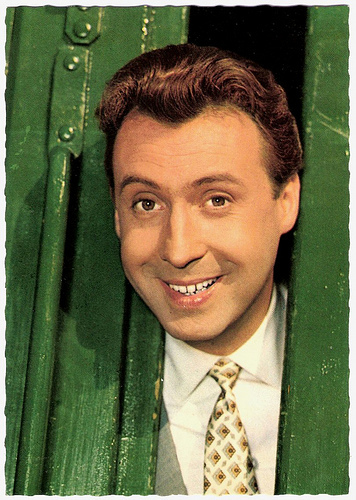
German postcard by ISV, no. H 142.
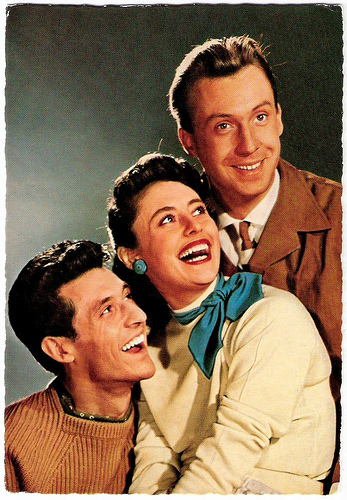
German postcard by WS-Druck, Wanne-Eickel, no. F 73. Photo: Lantin.
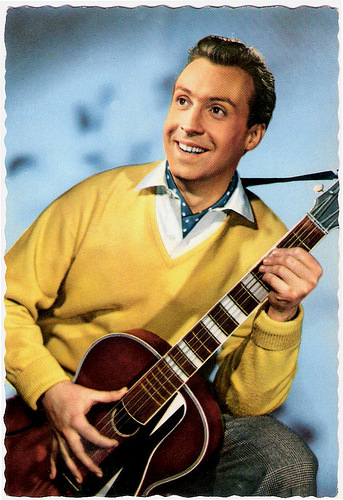
Belgian postcard by Edition H. Troukens, Hofstade, no. 1028. Photo: Ufa.
Prisoner-of-War
Peter Alexander was born in 1926 as Peter Alexander Ferdinand Maximilian Neumayer in Vienna, Austria. During World War II, he was a member of the Luftwaffenhelfer and the Reichsarbeitsdienst before being drafted into the navy. In 1945, he was captured by the British and held as a prisoner-of-war.
After the war he attended Vienna's Max Reinhardt Seminary until 1948 and then started a career as an actor. His first film appearance was an uncredited bit part in Der Engel mit der Posaune/The Angel with the Trumpet (Karl Hartl, 1948).
In 1951 Alexander released his first record, Das machen nur die Beine von Dolores, which reached the hit parade. Till 1982 there would be another 40 Top 10 hits and he sold a total of 46 million records.
From 1952 on he appeared as a singer in films like Verlorene Melodie/Vanished Melody (Eduard von Borsody, 1952), Salto Mortale (Viktor Tourjansky, 1953), and Die Große Starparade/The Big Star Parade (Paul Martin, 1954).
In 1953 he won the contest Deutschen Musikwettbewerb in München (Munich) before Vico Torriani and Gerhard Wendland.
The next year he starred with Caterina Valente and Silvio Francesco in the musical comedy Liebe, Tanz und 1000 Schlager/Love, Dance, and 1000 Songs (Paul Martin, 1955). The threesome appeared again in Bonjour Kathrin (Karl Anton, 1956).
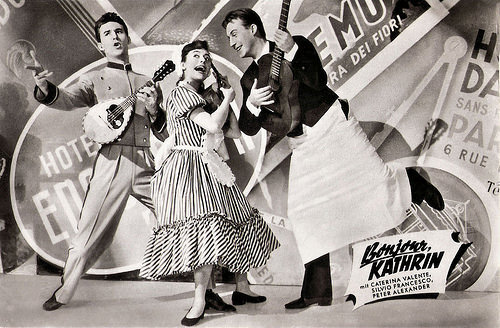
East-German postcard by VEB Progress Film-Vertrieb, no. 164, 1956. Retail price: 0,20 DM. Photo: publicity still for Bonjour, Kathrin (Karl Anton, 1956) with Caterina Valente and Silvio Francesco.
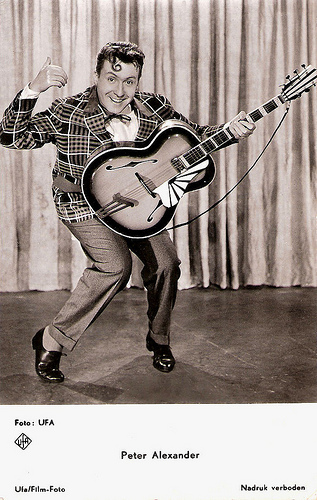
Dutch postcard by Gebr. Spanjersberg N.V., Rotterdam, no. 1222. Photo: Ufa.
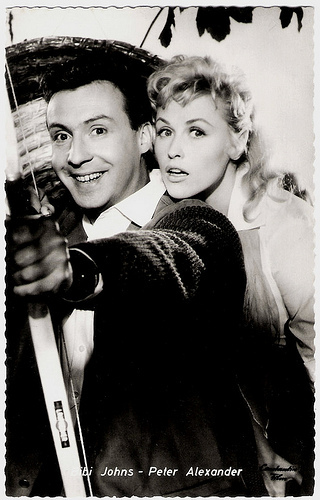
German postcard by Kolibri-Verlag, Minden/Westf., no. 399. Photo: Arthur Grimm / CCC / Constantin. Publicity still for Wehe, wenn sie losgelassen/Beware when she is released (Géza von Cziffra, 1958).
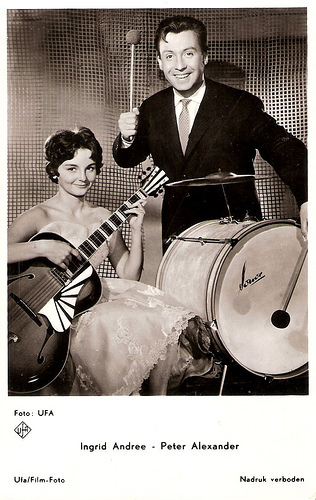
Dutch postcard by Gebr. Spanjersberg N.V., Rotterdam, no. 1218/459. Photo: UFA (Universum-Film Aktiengesellschaft, Berlin-Tempelhof). This is obviously a publicity still for the comedy Schlag auf Schlag/Blow On Blow (Géza von Cziffra, 1959) which starred Peter Alexander, Wolfgang Wahl, Ralf Wolter , and Ingrid Andree .
Count Bobby Pinelski
In the following decades Peter Alexander made some 30 entertainment films, including Ein Mann muß nicht immer schön sein/A Man Doesn't Always Need to Be Handsome (Hans Quest, 1956), Münchhausen in Afrika (Werner Jacobs, 1958), Peter schießt den Vogel ab/Peter Shoots the Bird (Géza von Cziffra, 1959), the operetta film Im weißen Rößl/The White Horse Inn (Werner Jacobs, 1960), the fine Jaroslav Hasek adaptation Schwejks Flegeljahre/Schweik's Years of Indiscretion (Wolfgang Liebeneiner, 1963), and Hilfe, meine Braut klaut/Help, My Bride Steals (Werner Jacobs, 1964) opposite Conny Froboess.
Günther Philipp was often his partner in these films. In the 1960s Peter Alexander also starred in the popular Count Bobby Pinelski films, like Die Abenteuer des Grafen Bobby/The Adventures of Count Bobby (Géza von Cziffra, 1961) with Vivi Bach, and the silly Luemmel-series, like Hurra, die Schule brennt/Hurrah, the School Is Burning (Werner Jacobs, 1969) with Dutch child star Heintje Simons.
In 1969, Peter Alexander started a second career as a TV host, with the Peter Alexander Show. He is considered Austria`s most popular entertainer of the 1970s and 1980s. He was famous for his parodies, including Queen Elizabeth II, and the four leading characters of the TV series The Golden Girls.
In 1952 Peter Alexander had married actress Hilde Haagen, who became his manager. The couple had two children, Susanne and Michael. Since the death of his wife in 2003, he has lived in his house in Vienna, completely retired from the public. His daughter, the artist Susanne Neumayer-Haidinger, passed away in 2009. Peter Alexander died in 2011, aged 84, in his native Vienna. He was survived by his son and two grandchildren.
Trailer Kriminaltango (Géza von Cziffra, 1960). Source: Arild Rafalzik (YouTube).
Schwejks Flegeljahre/Schweik's Years of Indiscretion (1963). Source: Fritz 51166 (YouTube).
Trailer of Hilfe, meine Braut klaut (1964) with Conny Froboess and Peter Alexander. Source: Conny Froboess (YouTube).
Trailer for Hauptsache Ferien (1972). Source: Rialto Film (YouTube).
Sources: Wikipedia and .

German postcard by ISV, no. H 142.

German postcard by WS-Druck, Wanne-Eickel, no. F 73. Photo: Lantin.

Belgian postcard by Edition H. Troukens, Hofstade, no. 1028. Photo: Ufa.
Prisoner-of-War
Peter Alexander was born in 1926 as Peter Alexander Ferdinand Maximilian Neumayer in Vienna, Austria. During World War II, he was a member of the Luftwaffenhelfer and the Reichsarbeitsdienst before being drafted into the navy. In 1945, he was captured by the British and held as a prisoner-of-war.
After the war he attended Vienna's Max Reinhardt Seminary until 1948 and then started a career as an actor. His first film appearance was an uncredited bit part in Der Engel mit der Posaune/The Angel with the Trumpet (Karl Hartl, 1948).
In 1951 Alexander released his first record, Das machen nur die Beine von Dolores, which reached the hit parade. Till 1982 there would be another 40 Top 10 hits and he sold a total of 46 million records.
From 1952 on he appeared as a singer in films like Verlorene Melodie/Vanished Melody (Eduard von Borsody, 1952), Salto Mortale (Viktor Tourjansky, 1953), and Die Große Starparade/The Big Star Parade (Paul Martin, 1954).
In 1953 he won the contest Deutschen Musikwettbewerb in München (Munich) before Vico Torriani and Gerhard Wendland.
The next year he starred with Caterina Valente and Silvio Francesco in the musical comedy Liebe, Tanz und 1000 Schlager/Love, Dance, and 1000 Songs (Paul Martin, 1955). The threesome appeared again in Bonjour Kathrin (Karl Anton, 1956).

East-German postcard by VEB Progress Film-Vertrieb, no. 164, 1956. Retail price: 0,20 DM. Photo: publicity still for Bonjour, Kathrin (Karl Anton, 1956) with Caterina Valente and Silvio Francesco.

Dutch postcard by Gebr. Spanjersberg N.V., Rotterdam, no. 1222. Photo: Ufa.

German postcard by Kolibri-Verlag, Minden/Westf., no. 399. Photo: Arthur Grimm / CCC / Constantin. Publicity still for Wehe, wenn sie losgelassen/Beware when she is released (Géza von Cziffra, 1958).

Dutch postcard by Gebr. Spanjersberg N.V., Rotterdam, no. 1218/459. Photo: UFA (Universum-Film Aktiengesellschaft, Berlin-Tempelhof). This is obviously a publicity still for the comedy Schlag auf Schlag/Blow On Blow (Géza von Cziffra, 1959) which starred Peter Alexander, Wolfgang Wahl, Ralf Wolter , and Ingrid Andree .
Count Bobby Pinelski
In the following decades Peter Alexander made some 30 entertainment films, including Ein Mann muß nicht immer schön sein/A Man Doesn't Always Need to Be Handsome (Hans Quest, 1956), Münchhausen in Afrika (Werner Jacobs, 1958), Peter schießt den Vogel ab/Peter Shoots the Bird (Géza von Cziffra, 1959), the operetta film Im weißen Rößl/The White Horse Inn (Werner Jacobs, 1960), the fine Jaroslav Hasek adaptation Schwejks Flegeljahre/Schweik's Years of Indiscretion (Wolfgang Liebeneiner, 1963), and Hilfe, meine Braut klaut/Help, My Bride Steals (Werner Jacobs, 1964) opposite Conny Froboess.
Günther Philipp was often his partner in these films. In the 1960s Peter Alexander also starred in the popular Count Bobby Pinelski films, like Die Abenteuer des Grafen Bobby/The Adventures of Count Bobby (Géza von Cziffra, 1961) with Vivi Bach, and the silly Luemmel-series, like Hurra, die Schule brennt/Hurrah, the School Is Burning (Werner Jacobs, 1969) with Dutch child star Heintje Simons.
In 1969, Peter Alexander started a second career as a TV host, with the Peter Alexander Show. He is considered Austria`s most popular entertainer of the 1970s and 1980s. He was famous for his parodies, including Queen Elizabeth II, and the four leading characters of the TV series The Golden Girls.
In 1952 Peter Alexander had married actress Hilde Haagen, who became his manager. The couple had two children, Susanne and Michael. Since the death of his wife in 2003, he has lived in his house in Vienna, completely retired from the public. His daughter, the artist Susanne Neumayer-Haidinger, passed away in 2009. Peter Alexander died in 2011, aged 84, in his native Vienna. He was survived by his son and two grandchildren.
Trailer Kriminaltango (Géza von Cziffra, 1960). Source: Arild Rafalzik (YouTube).
Schwejks Flegeljahre/Schweik's Years of Indiscretion (1963). Source: Fritz 51166 (YouTube).
Trailer of Hilfe, meine Braut klaut (1964) with Conny Froboess and Peter Alexander. Source: Conny Froboess (YouTube).
Trailer for Hauptsache Ferien (1972). Source: Rialto Film (YouTube).
Sources: Wikipedia and .
Published on August 20, 2015 22:00
August 19, 2015
Claudio Ermelli
Italian film actor Claudio Ermelli (1892-1964) played bit parts and character roles in more than 115 films, from 1915 to 1962.
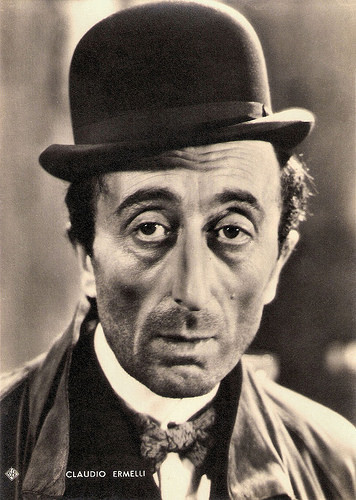
Italian postcard by ASER, Roma, no. 97. Photo: Pesce.
Mad Animals
Claudio Ermelli was born Ettore Foa in Turin, Italy in 1892. He was born into a family of Jewish origin. He followed in the footsteps of his physician father and joined the Faculty of Medicine. Then he interrupted his studies to pursue his true passion: the theatre and acting.
In 1915 he made his film debut in a supporting part as a sacristan in the silent short Silvio e lo Stradivarius/Silvio and the stradivarius (Ugo Falena, 1915), produced by Film d'Arte Italiana. In the 1990s this touching melodrama about an orphan boy (actress Silvia Malinverni) who loses his favourite violin, was discovered in the archive of the Dutch Filmmuseum.
After this film debut, Ermelli returned to the stage and became the manager of his own vaudeville company. After a long interval, he returned to the cinema in sound films like the comedy Zaganella e il cavaliere/Zaganella and the knight (Giorgio Mannini, Gustavo Serena, 1932) with Arturo Falconi and Marcella Albani , and Il dono del mattino/The gift of the morning (Enrico Guazzoni, 1932) with Germana Paolieri . In these films he always played character roles.
Throughout the 1930s, Ermelli played supporting parts in films like the comedy L'antenato/The Ancestor (Guido Brignone, 1936), starring Antonio Gandusio and Paola Barbara , the successful historical drama Il dottor Antonio/Doctor Antonio (Enrico Guazzoni, 1937), and the comedy I fratelli Castiglioni/The Castiglioni Brothers (Corrado D'Errico, 1937), starring Camillo Pilotto and Amedeo Nazzari . He also appeared with Totò in the comedy Animali pazzi/Mad Animals (Carlo Ludovico Bragaglia, 1939).
Although of Jewish origin, Ermelli never had problems, even after the racial laws of 1938. He continued playing supporting parts and small roles during the war years. Among his films were the drama La forza bruta/Brute Force (Carlo Ludovico Bragaglia 1941) with Juan de Landa and Rossano Brazzi, the comedy L'elisir d'amore (Amleo Palermi, 1941) with Arturo Falconi, and the Totò comedy Due cuori fra le belve/Two hearts among the beasts (Giorgio Simonelli, 1943).
The best known film of this period is Tosca (Jean Renoir, Carl Koch, 1941) in which Ermelli played the composer and director Paisiello, who despairs when Tosca ( Imperio Argentina ) repeatedly interrupts his repetitions for a royal performance.
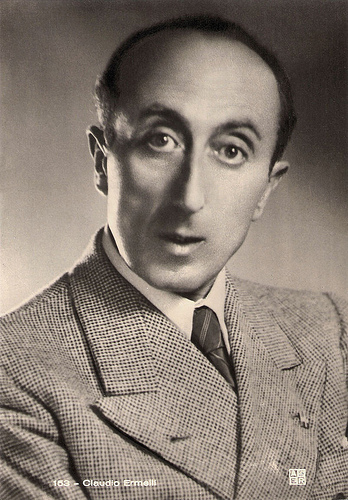
Italian postcard by ASER (A. Scaramiglia Edizioni, Roma), no. 163. Photographer unknown.
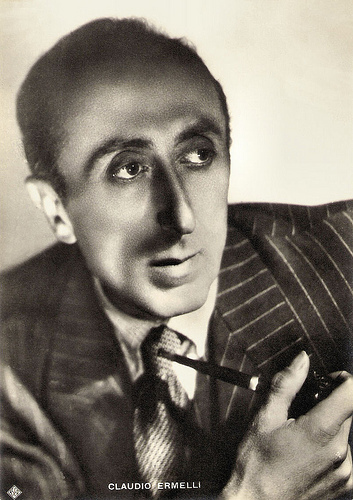
Italian postcard by ASER (A. Scaramiglia Edizioni, Roma). Photo: Fotopan.
Roman Holdiday
After the war, Claudio Ermelli often appeared on stage productions by directors like Luchino Visconti, Luciano Mondolfo and Luigi Squarzina.
On the screen he was seen in Sperduti nel buio/Lost in the Dark (Camillo Mastrocinque, 1947), which starred Vittorio De Sica . This Italian drama, based on a play by Roberto Bracco, was entered into the 1947 Cannes Film Festival. In 1914, it had already been made into a now lost silent film by Nino Martoglio with sets designed by the futurist architect Virgilio Marchi and with Maria Carmi as one of the stars.
One of Ermelli’s best known post-war films is the delicious romantic comedy Roman Holliday (William Wyler, 1953), with Audrey Hepburn as a royal princess out to see Rome on her own. She is guided by undercover journalist Gregory Peck. The film was shot at the Cinecittà studios and on location around Rome. Ermelli played Peck’s Italian neighbour Giovanni. Hilarious is the scene in which Peck lends some money to Hepburn for a taxi while Giovanni looks on, growing more and more convinced that he’s paying her for the night they spent together.
Ermelli played another funny character role in the American romantic comedy It Started in Naples (Melville Shavelson, 1960) with Clark Gable, Sophia Loren , and an Italian cast. His last screen appearance was in the TV series Una tragedia Americana/An American Tragedy (Anton Giulio Majano, 1962) with Virna Lisi .
Claudio Ermelli died in 1964 in Rome. He was 72.
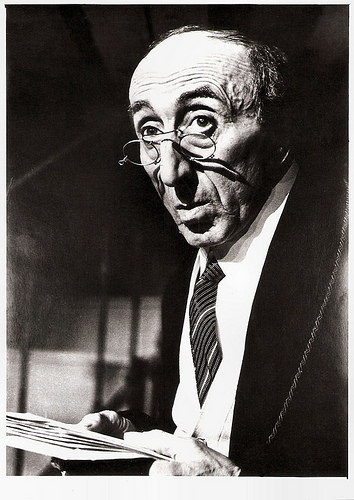
Vintage photo.
Source: Vittorio Martinelli (Il Cinema Muto Italiana 1915 II - Italian), AllMovie, Wikipedia (Italian and English) and .

Italian postcard by ASER, Roma, no. 97. Photo: Pesce.
Mad Animals
Claudio Ermelli was born Ettore Foa in Turin, Italy in 1892. He was born into a family of Jewish origin. He followed in the footsteps of his physician father and joined the Faculty of Medicine. Then he interrupted his studies to pursue his true passion: the theatre and acting.
In 1915 he made his film debut in a supporting part as a sacristan in the silent short Silvio e lo Stradivarius/Silvio and the stradivarius (Ugo Falena, 1915), produced by Film d'Arte Italiana. In the 1990s this touching melodrama about an orphan boy (actress Silvia Malinverni) who loses his favourite violin, was discovered in the archive of the Dutch Filmmuseum.
After this film debut, Ermelli returned to the stage and became the manager of his own vaudeville company. After a long interval, he returned to the cinema in sound films like the comedy Zaganella e il cavaliere/Zaganella and the knight (Giorgio Mannini, Gustavo Serena, 1932) with Arturo Falconi and Marcella Albani , and Il dono del mattino/The gift of the morning (Enrico Guazzoni, 1932) with Germana Paolieri . In these films he always played character roles.
Throughout the 1930s, Ermelli played supporting parts in films like the comedy L'antenato/The Ancestor (Guido Brignone, 1936), starring Antonio Gandusio and Paola Barbara , the successful historical drama Il dottor Antonio/Doctor Antonio (Enrico Guazzoni, 1937), and the comedy I fratelli Castiglioni/The Castiglioni Brothers (Corrado D'Errico, 1937), starring Camillo Pilotto and Amedeo Nazzari . He also appeared with Totò in the comedy Animali pazzi/Mad Animals (Carlo Ludovico Bragaglia, 1939).
Although of Jewish origin, Ermelli never had problems, even after the racial laws of 1938. He continued playing supporting parts and small roles during the war years. Among his films were the drama La forza bruta/Brute Force (Carlo Ludovico Bragaglia 1941) with Juan de Landa and Rossano Brazzi, the comedy L'elisir d'amore (Amleo Palermi, 1941) with Arturo Falconi, and the Totò comedy Due cuori fra le belve/Two hearts among the beasts (Giorgio Simonelli, 1943).
The best known film of this period is Tosca (Jean Renoir, Carl Koch, 1941) in which Ermelli played the composer and director Paisiello, who despairs when Tosca ( Imperio Argentina ) repeatedly interrupts his repetitions for a royal performance.

Italian postcard by ASER (A. Scaramiglia Edizioni, Roma), no. 163. Photographer unknown.

Italian postcard by ASER (A. Scaramiglia Edizioni, Roma). Photo: Fotopan.
Roman Holdiday
After the war, Claudio Ermelli often appeared on stage productions by directors like Luchino Visconti, Luciano Mondolfo and Luigi Squarzina.
On the screen he was seen in Sperduti nel buio/Lost in the Dark (Camillo Mastrocinque, 1947), which starred Vittorio De Sica . This Italian drama, based on a play by Roberto Bracco, was entered into the 1947 Cannes Film Festival. In 1914, it had already been made into a now lost silent film by Nino Martoglio with sets designed by the futurist architect Virgilio Marchi and with Maria Carmi as one of the stars.
One of Ermelli’s best known post-war films is the delicious romantic comedy Roman Holliday (William Wyler, 1953), with Audrey Hepburn as a royal princess out to see Rome on her own. She is guided by undercover journalist Gregory Peck. The film was shot at the Cinecittà studios and on location around Rome. Ermelli played Peck’s Italian neighbour Giovanni. Hilarious is the scene in which Peck lends some money to Hepburn for a taxi while Giovanni looks on, growing more and more convinced that he’s paying her for the night they spent together.
Ermelli played another funny character role in the American romantic comedy It Started in Naples (Melville Shavelson, 1960) with Clark Gable, Sophia Loren , and an Italian cast. His last screen appearance was in the TV series Una tragedia Americana/An American Tragedy (Anton Giulio Majano, 1962) with Virna Lisi .
Claudio Ermelli died in 1964 in Rome. He was 72.

Vintage photo.
Source: Vittorio Martinelli (Il Cinema Muto Italiana 1915 II - Italian), AllMovie, Wikipedia (Italian and English) and .
Published on August 19, 2015 22:00
August 18, 2015
Imported from the USA: Gordon Scott
Good-looking and muscular American actor Gordon Scott (1926–2007) is best known as the eleventh Tarzan. He portrayed Tarzan in five films from 1955 to 1960. Then Scott moved to Italy, where he became a popular star of the Peplum film genre, the sword-and-sandal epics. As the Peplum faded, Scott starred in Spaghetti Westerns and Eurospy films.

German collectors card by J & M Serienbilder Produktion Saar, no. 68. Photo: Gloria Film. Publicity still for Buffalo Bill, l'eroe del far west/Buffalo Bill, Hero of the Far West (Mario Costa, 1965). Caption: "In einem Zweikampf auf Leben und Tod hat Buffalo Bill, der berühmteste Held des Wilden Westens, seinen gefährlichsten Feind bezwungen. Der edle Kämpfer schenkt seinem Gegner das Leben. Die Indianer selbst sollen seine Strafe bestimmen." (In a duel to the death, Buffalo Bill, the famous hero of the Wild West, has defeated his most dangerous enemy. The noble warrior gives his opponent his life. The Indians themselves have to determine his punishment.)
Handsome features, muscular physique, and imposing height
Gordon Scott was born Gordon Merrill Werschkul in Portland, Oregon, in 1926. He was one of nine children of advertising man Stanley Werschkul and his wife Alice. He was raised in Oregon and studied Physical Education at the University of Oregon for one semester.
Upon leaving school, he joined the U.S. Army in 1944. He served as a drill sergeant and military policeman, and specialized in close order drill, judo and hand-to-hand combat. After his honourable discharge in 1947 he took on a variety of jobs, including fireman, cowboy, and farm-machinery salesman. In 1953 he was working as a lifeguard at the Sahara Hotel in Las Vegas when he was spotted by Hollywood agents, Ed and Walter Mayers. They were impressed by his handsome features, muscular physique, and imposing height.
Scott then beat out 200 contestants to replace Lex Barker as Edgar Rice Burroughs' famous jungle hero Tarzan. Film producer Sol Lesser offered him a 7 year contract, a loin cloth and a new last name. Reportedly, ‘Werschkul’ sounded too much like ‘Weissmuller’. So as Gordon Scott, he debuted in the low-budget Tarzan’s Hidden Jungle (Harold D. Schuster, 1955).
It led to a romance with co-star Vera Miles, who became his wife in 1956. They divorced in 1959. Tarzan’s Hidden Jungle was followed by Tarzan and the Lost Safari (H. Bruce Humberstone, 1957), the first Tarzan film in colour. It was filmed in Nairobi, British East Africa. In his early Tarzan films, Scott played the character as unworldly and inarticulate, in the mold of Johnny Weissmuller.
In 1958, Sol Lesser sold Scott's contract to Sy Weintraub. The new producer took his star to Paramount Pictures and, fueled by bigger production budgets, made two of the most successful Tarzan films, Tarzan's Greatest Adventure (John Guillermin, 1959) with Anthony Quayle and Sean Connery, and Tarzan the Magnificent (Robert Day, 1960) with Jock Mahoney. In these later films, Scott played a Tarzan who was educated and spoke perfect English, as in the original Edgar Rice Burroughs novels. Gordon Scott was the only actor to play Tarzan in both styles.
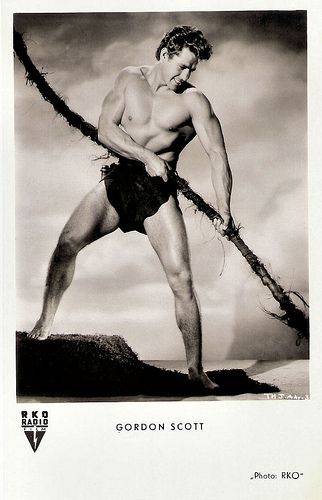
German postcard by Kunst und Bild, no. I 411. Photo: RKO. Publicity still for Tarzan's Hidden Jungle (Harold D. Schuster, 1955).
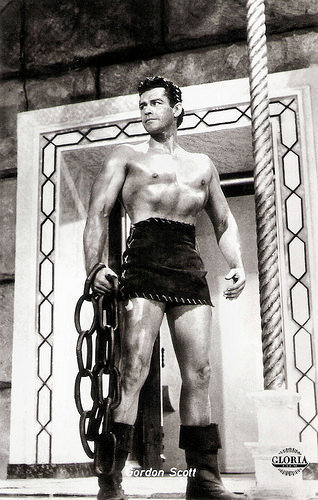
German postcard by Kolibri/Friedrich W. Sander-Verlag, Minden/Westf., no. 2322. Photo: Gloria Film. Publicity still for Maciste contro il vampiro/Maciste Vs. the Vampire (Giacomo Gentilomo, 1961).
Sword-and-sandal epics
Fearing he would become typecast as Tarzan, Gordon Scott moved to Italy. There he became a popular star of the Peplum genre, the sword-and-sandal epics featuring handsome bodybuilders as various characters from Greek and Roman myth.
Scott was an old training buddy of Hercules star Steve Reeves. Reeves had agreed to star in the Sergio Leone-penned saga Romolo e Remo/Duel of the Titans (Sergio Corbucci, 1961) about the two brothers of Roman Mythology, who founded Rome. The producer wanted Reeves to play both Romulus and Remus, but Reeves objected that the film would be more effective with another actor in the role of Remus. He recommended Gordon Scott, and the film co-starred Virna Lisi , Laura Solari, Massimo Girotti and Jacques Sernas . Scott was given the highest salary he had earned thus far for taking the role.
Next followed Maciste alla corte del Gran Khan/Maciste at the Court of the Great Khan (Riccardo Freda, 1961), which re-used the sets, extras and Yoko Tani as a princess from Marco Polo (Piero Pierotti, Hugo Fregonese, 1961) and Freda's I mongoli/The Mongols (André De Toth, Leopoldo Savona, Riccardo Freda, 1961).
Scott played Julius Caesar opposite Pascale Petit as Cleopatra in the historical drama Una regina per Cesare/A Queen for Caesar (Piero Pierotti, Victor Tourjansky, 1962) set in Egypt in 48 BC. Unlike other films about Caesar and Cleopatra, this film focuses entirely on the dynastic struggle within Egypt leading up to the arrival of Caesar, and in fact, we only see him in the closing scene of the film when he arrives at The Ptolemaic Palace in Alexandria. 20th Century Fox bought the rights for the film to keep it out of release lest it compete with their own Cleopatra, featuring Elizabeth Taylor. Scott also played Hercules in a couple of international co-productions during the mid-1960s.
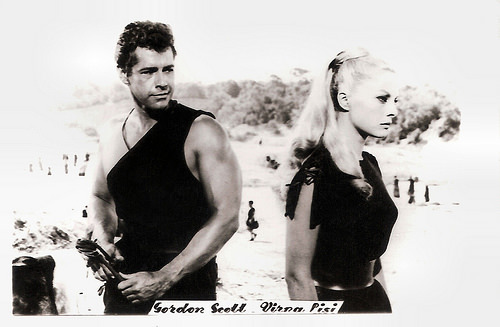
Small Romanian collectors card. Photo: publicity still for Romolo e Remo/Duel of the Titans (Sergio Corbucci, 1961).
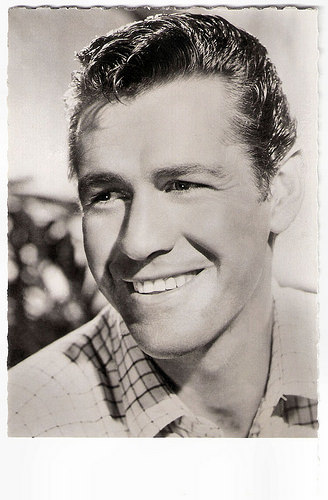
Vintage postcard.
Buffalo Bill
As the Peplum genre faded, Gordon Scott starred in other genre films. His first Spaghetti Western was Buffalo Bill, l'eroe del far west/Buffalo Bill, Hero of the Far West (Mario Costa, 1964) with Jan Hendriks .
He also starred in the Eurospy film Il Raggio infernale/Danger!! Death Ray (Gianfranco Baldanello, 1967), released at a time when the James Bond films, and spy films in general, were very popular internationally. His early military combat and martial arts training made it possible for him to do many of his own stunts.
His final film appearance was in the Spaghetti Western Gli uomini dal passo pesante/The Tramplers (Albert Band, Mario Sequi, 1966-1968) with Joseph Cotten and Franco Nero. He left Italy, and never made another film. He was trailed by a reputation as a ladies' man who seldom paid his bills, according to a 1987 article in the Toronto Star. For the last two decades of his life, Scott was a popular guest at film conventions and autograph shows and sold knives.
In 2007, Gordon Scott died, aged 80, in Baltimore, Maryland, of lingering complications from multiple heart surgeries earlier in the year. Adam Bernstein in his obituary in The Washington Post: “He lived with a series of obliging friends and ‘Tarzan’ fans, most recently in Baltimore. He had a troubled marriage to Miles, who apparently was under the impression that she was his first wife. She was his second or third, by varying accounts. He was seldom in contact with his surviving family, which includes a brother and two sisters. He had a son with Miles, and it's unclear how many other children he might have had. He was estranged from nearly everyone.”
Scott was married three times. His first marriage was with Janice Mae Wynkoop, of Oakland, California. They met when he was a lifeguard at Lake Temescal, located in Oakland, California. The couple married in Reno, Nevada, in 1948, and had one child, Karen Judith Werschkul (1948), before divorcing in 1949. His second marriage was to a woman he met while they were both working at the Sahara Hotel in Las Vegas. Gordon as a lifeguard and his wife as a PBX operator. They soon married and had a son, Eric, but the marriage ended once Gordon's acting career took off. With Vera Miles, he had one son, Michael (1957).
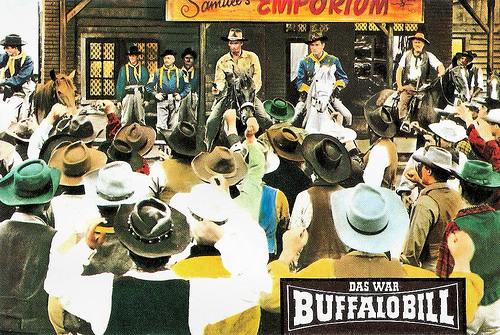
German collectors card by J & M Serienbilder Produktion Saar, no. 34. Photo: Gloria Film. Publicity still for Buffalo Bill, l'eroe del far west/Buffalo Bill, Hero of the Far West (Mario Costa, 1965) with Gordon Douglas. Caption: "Buffalo Bill hat sich auf die Fährte des weissen Waffenhändlers gesetzt, der die Rothäute zum Kampf aufwiegelt. Furchtlos hält Bill eine Übermacht rauher Burschen in Schach." (Buffalo Bill has set himself at the trail of the white arms dealer who incites the redskins to fight. Fearless Bill holds a a superior force of rough boys at bay.)
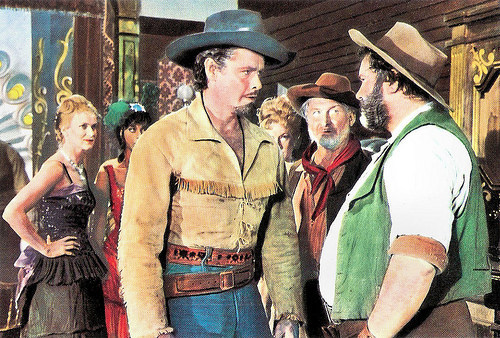
German collectors card by J & M Serienbilder Produktion Saar, no. 43. Photo: Gloria Film. Publicity still for Buffalo Bill, l'eroe del far west/Buffalo Bill, Hero of the Far West (Mario Costa, 1965) with Gordon Douglas. Caption: "Buffalo Bill begibt sich mit seinem Gefährten in die Höhle des Löwen. Als harmloser Gast horcht er in der Bar des Dunkelmannes Monroe herum, um zu erfahren wo die entführte Häuptlingstochter 'Mondstrahl' gefangen gehalten wird." (Buffalo Bill embarks with his companions in the lion's den. As harmless guest he listens around in the bar of the dark man Monroe to find out where 'Moonbeam', the chief's kidnapped daughter, is being held captive.)
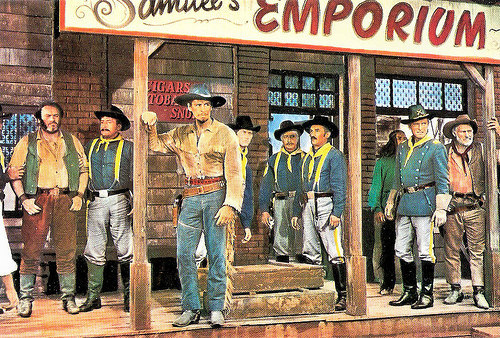
German collectors card by J & M Serienbilder Produktion Saar, no. 46. Photo: Gloria Film. Publicity still for Buffalo Bill, l'eroe del far west/Buffalo Bill, Hero of the Far West (Mario Costa, 1965). Caption: "Der erste Schurke, Big Sam, ist gefasst. Buffalo Bill hat bei ihm die Schiesseisen für die Rothäute gefunden. Big Sam gehört zu den Banditen, auf deren Konto die neunen Kämpfe zwischen Sioux und Weissen kommen." (The first villain, Big Sam is taken. Buffalo Bill has found at his place the firearms for the Redskins. Big Sam is one of the bandits, on whose account comes the new fighting between Sioux and whites.)
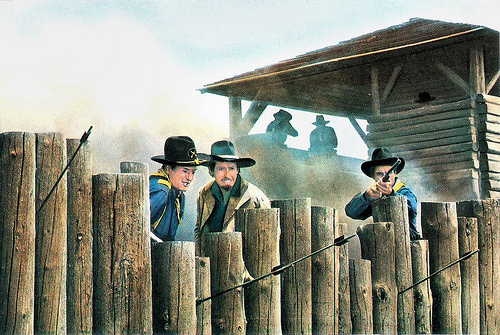
German collectors card by J & M Serienbilder Produktion Saar, no. 51. Photo: Gloria Film. Publicity still for Buffalo Bill, l'eroe del far west/Buffalo Bill, Hero of the Far West (Mario Costa, 1965) with Gordon Douglas. Caption: "'Gelbe Hand' vom Stamm der Sioux sieht seine hinterhältigen Manöver durchschaut. Er holt zum letzten Schlag gegen Fort Adam aus. Die von einem weissen Verräter gelieferten Feuerwaffen, den Buffalo Bill erledigt hat, sollen den Rothäuten den Sieg erkämpfen." ('Yellow Hand' of the tribe of Sioux sees his sneaky maneuver comprehended. He brings out the final blow to Fort Adam. The firearms, delivered by a white traitor, who Buffalo Bill has done in, have to help the Redskins to a victory.)
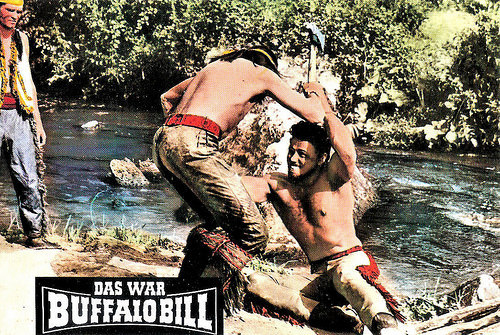
German collectors card by J & M Serienbilder Produktion Saar, no. 67. Photo: Gloria Film. Publicity still for Buffalo Bill, l'eroe del far west/Buffalo Bill, Hero of the Far West (Mario Costa, 1965) with Mirko Ellis and Gordon Scott (at right). Caption: "Wieder beweist der feige Häuptling Gelbe Hand'' im atemberaubenden Zweikampf mit Buffalo Bill seine Heimtücke. Er schmettert den Tomahawk auf den waffenlosen Gegner und deshalb verachten ihn jetzt sogar die eigenen Stammesgenossen." (Again the cowardly chief Yellow Hand hows his maliciousness in a breathtaking duel with Buffalo Bill. He smashes the Tomahawk on his unarmed opponent and therefore even his own tribesmen now despise him.)
Sources: Adam Bernstein (The Washington Post), Brian J. Walker (Brian’s Drive-In Theater), Bill Hillman (ERBzine), Mark Cerulli (Tarzan.cc), Wikipedia, and .

German collectors card by J & M Serienbilder Produktion Saar, no. 68. Photo: Gloria Film. Publicity still for Buffalo Bill, l'eroe del far west/Buffalo Bill, Hero of the Far West (Mario Costa, 1965). Caption: "In einem Zweikampf auf Leben und Tod hat Buffalo Bill, der berühmteste Held des Wilden Westens, seinen gefährlichsten Feind bezwungen. Der edle Kämpfer schenkt seinem Gegner das Leben. Die Indianer selbst sollen seine Strafe bestimmen." (In a duel to the death, Buffalo Bill, the famous hero of the Wild West, has defeated his most dangerous enemy. The noble warrior gives his opponent his life. The Indians themselves have to determine his punishment.)
Handsome features, muscular physique, and imposing height
Gordon Scott was born Gordon Merrill Werschkul in Portland, Oregon, in 1926. He was one of nine children of advertising man Stanley Werschkul and his wife Alice. He was raised in Oregon and studied Physical Education at the University of Oregon for one semester.
Upon leaving school, he joined the U.S. Army in 1944. He served as a drill sergeant and military policeman, and specialized in close order drill, judo and hand-to-hand combat. After his honourable discharge in 1947 he took on a variety of jobs, including fireman, cowboy, and farm-machinery salesman. In 1953 he was working as a lifeguard at the Sahara Hotel in Las Vegas when he was spotted by Hollywood agents, Ed and Walter Mayers. They were impressed by his handsome features, muscular physique, and imposing height.
Scott then beat out 200 contestants to replace Lex Barker as Edgar Rice Burroughs' famous jungle hero Tarzan. Film producer Sol Lesser offered him a 7 year contract, a loin cloth and a new last name. Reportedly, ‘Werschkul’ sounded too much like ‘Weissmuller’. So as Gordon Scott, he debuted in the low-budget Tarzan’s Hidden Jungle (Harold D. Schuster, 1955).
It led to a romance with co-star Vera Miles, who became his wife in 1956. They divorced in 1959. Tarzan’s Hidden Jungle was followed by Tarzan and the Lost Safari (H. Bruce Humberstone, 1957), the first Tarzan film in colour. It was filmed in Nairobi, British East Africa. In his early Tarzan films, Scott played the character as unworldly and inarticulate, in the mold of Johnny Weissmuller.
In 1958, Sol Lesser sold Scott's contract to Sy Weintraub. The new producer took his star to Paramount Pictures and, fueled by bigger production budgets, made two of the most successful Tarzan films, Tarzan's Greatest Adventure (John Guillermin, 1959) with Anthony Quayle and Sean Connery, and Tarzan the Magnificent (Robert Day, 1960) with Jock Mahoney. In these later films, Scott played a Tarzan who was educated and spoke perfect English, as in the original Edgar Rice Burroughs novels. Gordon Scott was the only actor to play Tarzan in both styles.

German postcard by Kunst und Bild, no. I 411. Photo: RKO. Publicity still for Tarzan's Hidden Jungle (Harold D. Schuster, 1955).

German postcard by Kolibri/Friedrich W. Sander-Verlag, Minden/Westf., no. 2322. Photo: Gloria Film. Publicity still for Maciste contro il vampiro/Maciste Vs. the Vampire (Giacomo Gentilomo, 1961).
Sword-and-sandal epics
Fearing he would become typecast as Tarzan, Gordon Scott moved to Italy. There he became a popular star of the Peplum genre, the sword-and-sandal epics featuring handsome bodybuilders as various characters from Greek and Roman myth.
Scott was an old training buddy of Hercules star Steve Reeves. Reeves had agreed to star in the Sergio Leone-penned saga Romolo e Remo/Duel of the Titans (Sergio Corbucci, 1961) about the two brothers of Roman Mythology, who founded Rome. The producer wanted Reeves to play both Romulus and Remus, but Reeves objected that the film would be more effective with another actor in the role of Remus. He recommended Gordon Scott, and the film co-starred Virna Lisi , Laura Solari, Massimo Girotti and Jacques Sernas . Scott was given the highest salary he had earned thus far for taking the role.
Next followed Maciste alla corte del Gran Khan/Maciste at the Court of the Great Khan (Riccardo Freda, 1961), which re-used the sets, extras and Yoko Tani as a princess from Marco Polo (Piero Pierotti, Hugo Fregonese, 1961) and Freda's I mongoli/The Mongols (André De Toth, Leopoldo Savona, Riccardo Freda, 1961).
Scott played Julius Caesar opposite Pascale Petit as Cleopatra in the historical drama Una regina per Cesare/A Queen for Caesar (Piero Pierotti, Victor Tourjansky, 1962) set in Egypt in 48 BC. Unlike other films about Caesar and Cleopatra, this film focuses entirely on the dynastic struggle within Egypt leading up to the arrival of Caesar, and in fact, we only see him in the closing scene of the film when he arrives at The Ptolemaic Palace in Alexandria. 20th Century Fox bought the rights for the film to keep it out of release lest it compete with their own Cleopatra, featuring Elizabeth Taylor. Scott also played Hercules in a couple of international co-productions during the mid-1960s.

Small Romanian collectors card. Photo: publicity still for Romolo e Remo/Duel of the Titans (Sergio Corbucci, 1961).

Vintage postcard.
Buffalo Bill
As the Peplum genre faded, Gordon Scott starred in other genre films. His first Spaghetti Western was Buffalo Bill, l'eroe del far west/Buffalo Bill, Hero of the Far West (Mario Costa, 1964) with Jan Hendriks .
He also starred in the Eurospy film Il Raggio infernale/Danger!! Death Ray (Gianfranco Baldanello, 1967), released at a time when the James Bond films, and spy films in general, were very popular internationally. His early military combat and martial arts training made it possible for him to do many of his own stunts.
His final film appearance was in the Spaghetti Western Gli uomini dal passo pesante/The Tramplers (Albert Band, Mario Sequi, 1966-1968) with Joseph Cotten and Franco Nero. He left Italy, and never made another film. He was trailed by a reputation as a ladies' man who seldom paid his bills, according to a 1987 article in the Toronto Star. For the last two decades of his life, Scott was a popular guest at film conventions and autograph shows and sold knives.
In 2007, Gordon Scott died, aged 80, in Baltimore, Maryland, of lingering complications from multiple heart surgeries earlier in the year. Adam Bernstein in his obituary in The Washington Post: “He lived with a series of obliging friends and ‘Tarzan’ fans, most recently in Baltimore. He had a troubled marriage to Miles, who apparently was under the impression that she was his first wife. She was his second or third, by varying accounts. He was seldom in contact with his surviving family, which includes a brother and two sisters. He had a son with Miles, and it's unclear how many other children he might have had. He was estranged from nearly everyone.”
Scott was married three times. His first marriage was with Janice Mae Wynkoop, of Oakland, California. They met when he was a lifeguard at Lake Temescal, located in Oakland, California. The couple married in Reno, Nevada, in 1948, and had one child, Karen Judith Werschkul (1948), before divorcing in 1949. His second marriage was to a woman he met while they were both working at the Sahara Hotel in Las Vegas. Gordon as a lifeguard and his wife as a PBX operator. They soon married and had a son, Eric, but the marriage ended once Gordon's acting career took off. With Vera Miles, he had one son, Michael (1957).

German collectors card by J & M Serienbilder Produktion Saar, no. 34. Photo: Gloria Film. Publicity still for Buffalo Bill, l'eroe del far west/Buffalo Bill, Hero of the Far West (Mario Costa, 1965) with Gordon Douglas. Caption: "Buffalo Bill hat sich auf die Fährte des weissen Waffenhändlers gesetzt, der die Rothäute zum Kampf aufwiegelt. Furchtlos hält Bill eine Übermacht rauher Burschen in Schach." (Buffalo Bill has set himself at the trail of the white arms dealer who incites the redskins to fight. Fearless Bill holds a a superior force of rough boys at bay.)

German collectors card by J & M Serienbilder Produktion Saar, no. 43. Photo: Gloria Film. Publicity still for Buffalo Bill, l'eroe del far west/Buffalo Bill, Hero of the Far West (Mario Costa, 1965) with Gordon Douglas. Caption: "Buffalo Bill begibt sich mit seinem Gefährten in die Höhle des Löwen. Als harmloser Gast horcht er in der Bar des Dunkelmannes Monroe herum, um zu erfahren wo die entführte Häuptlingstochter 'Mondstrahl' gefangen gehalten wird." (Buffalo Bill embarks with his companions in the lion's den. As harmless guest he listens around in the bar of the dark man Monroe to find out where 'Moonbeam', the chief's kidnapped daughter, is being held captive.)

German collectors card by J & M Serienbilder Produktion Saar, no. 46. Photo: Gloria Film. Publicity still for Buffalo Bill, l'eroe del far west/Buffalo Bill, Hero of the Far West (Mario Costa, 1965). Caption: "Der erste Schurke, Big Sam, ist gefasst. Buffalo Bill hat bei ihm die Schiesseisen für die Rothäute gefunden. Big Sam gehört zu den Banditen, auf deren Konto die neunen Kämpfe zwischen Sioux und Weissen kommen." (The first villain, Big Sam is taken. Buffalo Bill has found at his place the firearms for the Redskins. Big Sam is one of the bandits, on whose account comes the new fighting between Sioux and whites.)

German collectors card by J & M Serienbilder Produktion Saar, no. 51. Photo: Gloria Film. Publicity still for Buffalo Bill, l'eroe del far west/Buffalo Bill, Hero of the Far West (Mario Costa, 1965) with Gordon Douglas. Caption: "'Gelbe Hand' vom Stamm der Sioux sieht seine hinterhältigen Manöver durchschaut. Er holt zum letzten Schlag gegen Fort Adam aus. Die von einem weissen Verräter gelieferten Feuerwaffen, den Buffalo Bill erledigt hat, sollen den Rothäuten den Sieg erkämpfen." ('Yellow Hand' of the tribe of Sioux sees his sneaky maneuver comprehended. He brings out the final blow to Fort Adam. The firearms, delivered by a white traitor, who Buffalo Bill has done in, have to help the Redskins to a victory.)

German collectors card by J & M Serienbilder Produktion Saar, no. 67. Photo: Gloria Film. Publicity still for Buffalo Bill, l'eroe del far west/Buffalo Bill, Hero of the Far West (Mario Costa, 1965) with Mirko Ellis and Gordon Scott (at right). Caption: "Wieder beweist der feige Häuptling Gelbe Hand'' im atemberaubenden Zweikampf mit Buffalo Bill seine Heimtücke. Er schmettert den Tomahawk auf den waffenlosen Gegner und deshalb verachten ihn jetzt sogar die eigenen Stammesgenossen." (Again the cowardly chief Yellow Hand hows his maliciousness in a breathtaking duel with Buffalo Bill. He smashes the Tomahawk on his unarmed opponent and therefore even his own tribesmen now despise him.)
Sources: Adam Bernstein (The Washington Post), Brian J. Walker (Brian’s Drive-In Theater), Bill Hillman (ERBzine), Mark Cerulli (Tarzan.cc), Wikipedia, and .
Published on August 18, 2015 22:00
Paul van Yperen's Blog
- Paul van Yperen's profile
- 13 followers
Paul van Yperen isn't a Goodreads Author
(yet),
but they
do have a blog,
so here are some recent posts imported from
their feed.



